Spring 2015
Editor’s Note
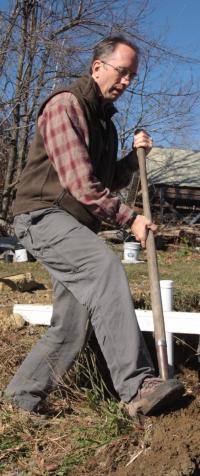 In Life of Pi, Yann Martel writes, “I suppose in the end the whole of life becomes an act of letting go. But what always hurts the most is not taking a moment to say goodbye.” We take the time to say several goodbyes in this issue of Potash Hill, principal among them a fond farewell to our fearless leader President Ellen McCulloch-Lovell, who will be moving on to hopefully more relaxing things in July.
In Life of Pi, Yann Martel writes, “I suppose in the end the whole of life becomes an act of letting go. But what always hurts the most is not taking a moment to say goodbye.” We take the time to say several goodbyes in this issue of Potash Hill, principal among them a fond farewell to our fearless leader President Ellen McCulloch-Lovell, who will be moving on to hopefully more relaxing things in July.
Ellen has always impressed me with her ability to hold a space, whether that’s in the midst of a noisy Town Meeting or a full-house commencement, with warmth and grace. We could hardly do better than remembering Ellen with a heartfelt, personal tribute from our own Peter Mallary, alumnus, parent, and loyal longtime trustee.
We also take the time to say goodbye to two beloved faculty members, Jaysinh Birjepatil and Willene Clark, who died in January. Each of them left their unique mark on Marlboro during their tenures, as well as after retirement, and the community will miss their presence.
If you don’t already know, I am happy to inform you that Marlboro has appointed Ellen’s successor, Kevin Quigley, who will start serving as president on July 1. Kevin was chosen by a multi-constituent search committee, after an exhaustive process that started with over 200 applicants and ended with his visit to campus in February for all to meet. We look forward to sharing more about Kevin in the next issue of Potash Hill, but in the meantime you can learn a bit on our website under News & Events.
As the snow slowly subsides and is replaced by snowy mud, and then by just mud, and eventually the fullness of spring, we at Marlboro are well aware that nothing stays the same. We are grateful for the positive role so many people have played in making the college what it is, and are heartened by the thought of the many more to come.
Inside Front Cover
Potash Hill
Published twice every year, Potash Hill shares highlights of what Marlboro College community members, in both undergraduate and graduate programs, are doing, creating, and thinking. The publication is named after the hill in Marlboro, Vermont, where the undergraduate campus was founded in 1946. “Potash,” or potassium carbonate, was a locally important industry in the 18th and 19th centuries, obtained by leaching wood ash and evaporating the result in large iron pots. Students and faculty at Marlboro no longer make potash, but they are very industrious in their own way, as this publication amply demonstrates.
Editor: Philip Johansson
Photo Editor: Ella McIntosh
Design: New Ground Creative
Potash Hill welcomes letters to the editor. Mail them to: Editor, Potash Hill, Marlboro College, P.O. Box A, Marlboro, VT 05344, or send email to pjohansson@marlboro.edu. The editor reserves the right to edit for length letters that appear in Potash Hill.
Front Cover: Boot prints along the fire-pond path chart the progress of time and motion at Marlboro College. All community members leave their mark on campus, and none more indelibly than President Ellen McCulloch-Lovell, who steps down this summer.
 What does a liberal arts education mean to you? To Marlboro junior Edward Suprenant, pictured right, writing is a craft like any other, and free-thinking is a skill to be honed at college. Find out more in a video profile.
What does a liberal arts education mean to you? To Marlboro junior Edward Suprenant, pictured right, writing is a craft like any other, and free-thinking is a skill to be honed at college. Find out more in a video profile.
Marlboro College Mission Statement
The goal of the undergraduate program at Marlboro College is to teach students to think clearly and to learn independently through engagement in a structured program of liberal studies. Students are expected to develop a command of concise and correct English and to strive for academic excellence informed by intellectual and artistic creativity; they are encouraged to acquire a passion for learning, discerning judgment, and a global perspective. The college promotes independence by requiring students to participate in the planning of their own programs of study and to act responsibly within a self-governing community.
The mission of Marlboro College Graduate and Professional Studies program is to offer responsive, innovative education of the highest standard in professional studies in the topic areas of management, technology, and teaching. The educational practice of the graduate program fosters the development of critical thinking, articulate presentation, coherent concepts and arguments, superior writing skills, and the ability to apply creative, sustainable solutions to real world problems.
Up Front
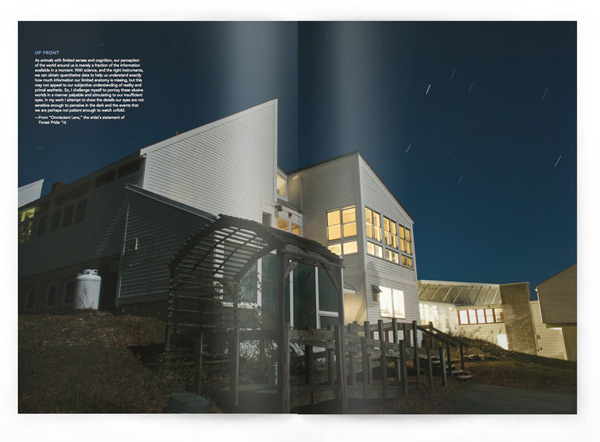
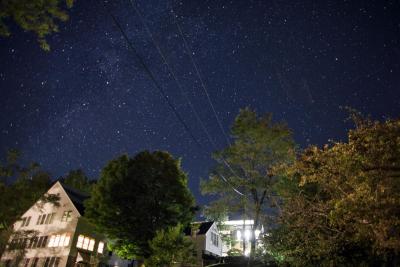 As animals with limited senses and cognition, our perception of the world around us is merely a fraction of the information available in a moment. With science, and the right instruments, we can obtain quantitative data to help us understand exactly how much information our limited anatomy is missing, but this may not appeal to our subjective understanding of reality and primal aesthetic. So, I challenge myself to portray these elusive worlds in a manner palpable and stimulating to our insufficient eyes. In my work I attempt to show the details our eyes are not sensitive enough to perceive in the dark and the events that we are perhaps not patient enough to watch unfold.
As animals with limited senses and cognition, our perception of the world around us is merely a fraction of the information available in a moment. With science, and the right instruments, we can obtain quantitative data to help us understand exactly how much information our limited anatomy is missing, but this may not appeal to our subjective understanding of reality and primal aesthetic. So, I challenge myself to portray these elusive worlds in a manner palpable and stimulating to our insufficient eyes. In my work I attempt to show the details our eyes are not sensitive enough to perceive in the dark and the events that we are perhaps not patient enough to watch unfold.
— From “Omniscient Lens,” the artist’s statement of Forest Pride ’16
Clear Writing
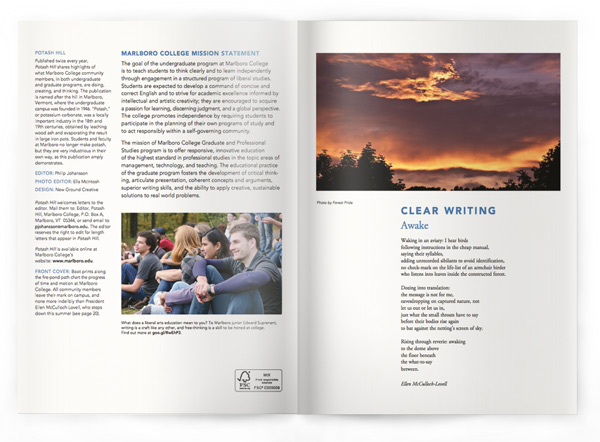
Awake
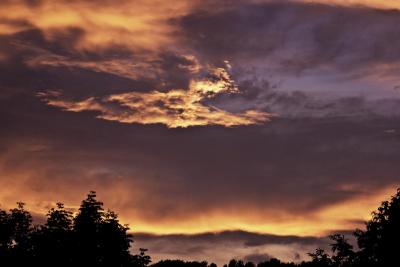 Waking in an aviary: I hear birds
Waking in an aviary: I hear birds
following instructions in the cheap manual,
saying their syllables,
adding unrecorded sibilants to avoid identification,
no check-mark on the life-list of an armchair birder
who listens into leaves inside the constructed forest.
Dozing into translation:
the message is not for me,
eavesdropping on captured nature, not
let us out or let us in,
just what the small throats have to say
before their bodies rise again
to bat against the netting’s screen of sky.
Rising through reverie: awaking
to the dome above
the floor beneath
the what-to-say
between.
Ellen McCulloch-Lovell
Letters
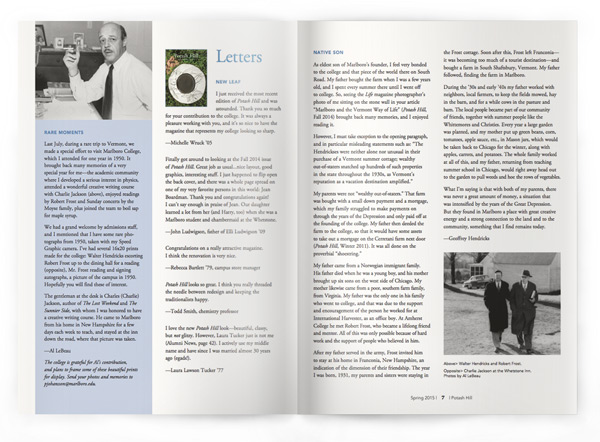
Rare MomentsLast July, during a rare trip to Vermont, we made a special effort to visit Marlboro College, which I attended for one year in 1950. It brought back many memories of a very special year for me—the academic community where I developed a serious interest in physics, attended a wonderful creative writing course with Charlie Jackson (right), enjoyed readings by Robert Frost and Sunday concerts by the Moyse family, plus joined the team to boil sap for maple syrup.
We had a grand welcome by admissions staff, and I mentioned that I have some rare photographs from 1950, taken with my Speed Graphic camera. I’ve had several 16x20 prints made for the college: Walter Hendricks escorting Robert Frost up to the dining hall for a reading (below), Mr. Frost reading and signing autographs, a picture of the campus in 1950. Hopefully you will find these of interest.
The gentleman at the desk is Charles (Charlie) Jackson, author of The Lost Weekend and The Sunnier Side, with whom I was honored to have a creative writing course. He came to Marlboro from his home in New Hampshire for a few days each week to teach, and stayed at the inn down the road, where that picture was taken. —Al LeBeau
The college is grateful for Al’s contribution, and plans to frame some of these beautiful prints for display. Send your photos and memories to pjohansson@marlboro.edu.
New Leaf
I just received the most recent edition of Potash Hill and was astounded. Thank you so much for your contribution to the college. It was always a pleasure working with you, and it’s so nice to have the magazine that represents my college looking so sharp.
—Michelle Wruck ’05
Finally got around to looking at the Fall 2014 issue of Potash Hill. Great job as usual...nice layout, good graphics, interesting stuff. I just happened to flip open the back cover, and there was a whole page spread on one of my very favorite persons in this world: Jean Boardman. Thank you and congratulations again! I can’t say enough in praise of Jean. Our daughter learned a lot from her (and Harry, too) when she was a Marlboro student and chambermaid at the Whetstone.
—John Ludwigson, father of Elli Ludwigson ’09
Congratulations on a really attractive magazine. I think the renovation is very nice.
—Rebecca Bartlett ’79, campus store manager
Potash Hill looks so great. I think you really threaded the needle between redesign and keeping the traditionalists happy.
—Todd Smith, chemistry professor
I love the new Potash Hill look—beautiful, classy, but not glitzy. However, Laura Tucker just is not me (Alumni News, page 42). I actively use my middle name and have since I was married almost 30 years ago (egads!).
—Laura Lawson Tucker ’77
Native Son
As eldest son of Marlboro’s founder, I feel very bonded to the college and that piece of the world there on South Road. My father bought the farm when I was a few years old, and I spent every summer there until I went off to college. So, seeing the Life magazine photographer’s photo of me sitting on the stone wall in your article “Marlboro and the Vermont Way of Life” (Potash Hill, Fall 2014) brought back many memories, and I enjoyed reading it.
However, I must take exception to the opening paragraph, and in particular misleading statements such as: “The Hendrickses were neither alone nor unusual in their purchase of a Vermont summer cottage; wealthy out-of-staters snatched up hundreds of such properties in the state throughout the 1930s, as Vermont’s reputation as a vacation destination amplified.”
My parents were not “wealthy out-of-staters.” That farm was bought with a small down payment and a mortgage, which my family struggled to make payments on through the years of the Depression and only paid off at the founding of the college. My father then deeded the farm to the college, so that it would have some assets to take out a mortgage on the Cerretani farm next door (Potash Hill, Winter 2011). It was all done on the proverbial “shoestring.”
My father came from a Norwegian immigrant family. His father died when he was a young boy, and his mother brought up six sons on the west side of Chicago. My mother likewise came from a poor, southern farm family, from Virginia. My father was the only one in his family who went to college, and that was due to the support and encouragement of the person he worked for at International Harvester, as an office boy. At Amherst College he met Robert Frost, who became a lifelong friend and mentor. All of this was only possible because of hard work and the support of people who believed in him.
After my father served in the army, Frost invited him to stay at his home in Franconia, New Hampshire, an indication of the dimension of their friendship. The year I was born, 1931, my parents and sisters were staying in the Frost cottage. Soon after this, Frost left Franconia— it was becoming too much of a tourist destination—and bought a farm in South Shaftsbury, Vermont. My father followed, finding the farm in Marlboro.
During the ’30s and early ’40s my father worked with neighbors, local farmers, to keep the fields mowed, hay in the barn, and for a while cows in the pasture and barn. The local people became part of our community of friends, together with summer people like the Whittemores and Christies. Every year a large garden was planted, and my mother put up green beans, corn, tomatoes, apple sauce, etc., in Mason jars, which would be taken back to Chicago for the winter, along with apples, carrots, and potatoes. The whole family worked at all of this, and my father, returning from teaching summer school in Chicago, would right away head out to the garden to pull weeds and hoe the rows of vegetables.
What I’m saying is that with both of my parents, there was never a great amount of money, a situation that was intensified by the years of the Great Depression. But they found in Marlboro a place with great creative energy and a strong connection to the land and to the community, something that I find remains today.
—Geoffrey Hendricks
Only Women Will Heal Me
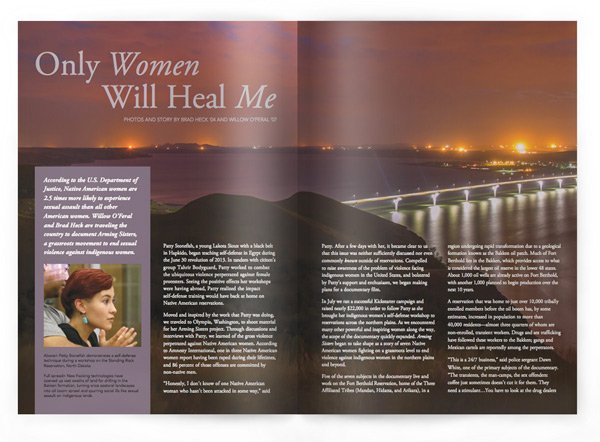
Photos and Story by Brad Heck ’04 and Willow O’Feral ‘07
According to the U.S. Department of Justice, Native American women are 2.5 times more likely to experience sexual assault than all other American women. Willow O’Feral and Brad Heck are traveling the country to document Arming Sisters, a grassroots movement to end sexual violence against indigenous women.
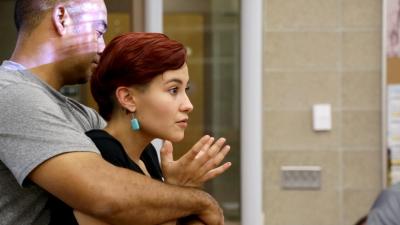 Patty Stonefish, a young Lakota Sioux with a black belt in Hapkido, began teaching self-defense in Egypt during the June 30 revolution of 2013. In tandem with citizen’s group Tahrir Bodyguard, Patty worked to combat the ubiquitous violence perpetrated against female protesters. Seeing the positive effects her workshops were having abroad, Patty realized the impact self-defense training would have back at home on Native American reservations.
Patty Stonefish, a young Lakota Sioux with a black belt in Hapkido, began teaching self-defense in Egypt during the June 30 revolution of 2013. In tandem with citizen’s group Tahrir Bodyguard, Patty worked to combat the ubiquitous violence perpetrated against female protesters. Seeing the positive effects her workshops were having abroad, Patty realized the impact self-defense training would have back at home on Native American reservations.
Moved and inspired by the work that Patty was doing, we traveled to Olympia, Washington, to shoot material for her Arming Sisters project. Through discussions and interviews with Patty, we learned of the gross violence perpetrated against Native American women. According to Amnesty International, one in three Native American women report having been raped during their lifetimes, and 86 percent of those offenses are committed by non-native men.
“Honestly, I don’t know of one Native American woman who hasn’t been attacked in some way,” said Patty. After a few days with her, it became clear to us that this issue was neither sufficiently discussed nor even commonly known outside of reservations. Compelled to raise awareness of the problem of violence facing indigenous women in the United States, and bolstered by Patty’s support and enthusiasm, we began making plans for a documentary film.
In July we ran a successful Kickstarter campaign and raised nearly $22,000 in order to follow Patty as she brought her indigenous women’s self-defense workshop to reservations across the northern plains. As we encountered many other powerful and inspiring women along the way, the scope of the documentary quickly expanded. Arming Sisters began to take shape as a story of seven Native American women fighting on a grassroots level to end violence against indigenous women in the northern plains and beyond.
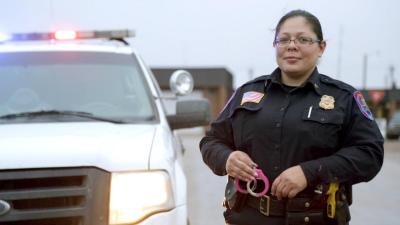 Five of the seven subjects in the documentary live and work on the Fort Berthold Reservation, home of the Three Affiliated Tribes (Mandan, Hidatsa, and Arikara), in a region undergoing rapid transformation due to a geological formation known as the Bakken oil patch. Much of Fort Berthold lies in the Bakken, which provides access to what is considered the largest oil reserve in the lower 48 states. About 1,000 oil wells are already active on Fort Berthold, with another 1,000 planned to begin production over the next 10 years.
Five of the seven subjects in the documentary live and work on the Fort Berthold Reservation, home of the Three Affiliated Tribes (Mandan, Hidatsa, and Arikara), in a region undergoing rapid transformation due to a geological formation known as the Bakken oil patch. Much of Fort Berthold lies in the Bakken, which provides access to what is considered the largest oil reserve in the lower 48 states. About 1,000 oil wells are already active on Fort Berthold, with another 1,000 planned to begin production over the next 10 years.
A reservation that was home to just over 10,000 tribally enrolled members before the oil boom has, by some estimates, increased in population to more than 40,000 residents—almost three quarters of whom are non-enrolled, transient workers. Drugs and sex trafficking have followed these workers to the Bakken; gangs and Mexican cartels are reportedly among the perpetrators.
“This is a 24/7 business,” said police sergeant Dawn White, one of the primary subjects of the documentary. “The transients, the man-camps, the sex offenders: coffee just sometimes doesn’t cut it for them. They need a stimulant…You have to look at the drug dealers as business men…they’re going where the money’s at, and the money’s right here.”
Dawn is a pillar within the Fort Berthold community, one of the first women to receive the Champions of Public Safety in Indian Country Award (June 2014). We spent several nights riding along with Dawn as she patrolled the reservation. Dawn’s approach to her job requires a difficult balance of holding community members responsible for their actions while at the same time not taking their infractions personally and forgiving them the following day. There were few members she stopped whom she did not know by name, and many were related to her.
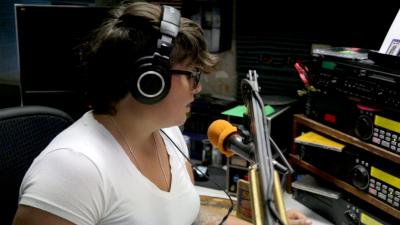 Dawn is also a survivor of sexual assault. Before becoming a police officer she was enrolled in the military, and while stationed in Germany she was sexually assaulted by another soldier. The trauma will “always be with me,” said Dawn. “It will never go away.” She described how the experience informs her work: “It does carry over to the job…being a survivor of [sexual assault] I know what that fear is, I know how it grips you…and it has helped, because I want to catch this person for them, I want to bring them to justice.”
Dawn is also a survivor of sexual assault. Before becoming a police officer she was enrolled in the military, and while stationed in Germany she was sexually assaulted by another soldier. The trauma will “always be with me,” said Dawn. “It will never go away.” She described how the experience informs her work: “It does carry over to the job…being a survivor of [sexual assault] I know what that fear is, I know how it grips you…and it has helped, because I want to catch this person for them, I want to bring them to justice.”
Bringing perpetrators of sexual assault to justice is difficult on a reservation, especially when the assailant is a non-enrolled member. The semi-sovereign state of Indian reservations requires coordination between tribal, state, and federal government agencies during investigations, and often in the case of a non-enrolled assailant, the burden of prosecution lies with the federal government. This results in a lot of jurisdictional pitfalls, and many cases get dropped before they ever come to trial. According the The Atlantic magazine, “In 2011, the U.S. Justice Department did not prosecute 65 percent of rape cases reported on reservations.”
Chalsey Snyder, an enrolled member of the Three Affiliated Tribes and another subject of the documentary, is working to increase the jurisdictional power of the Fort Berthold tribal government in cases of sex trafficking. She is writing tribal code that broadens the legal definition of sex trafficking and nearly triples the penalties and fines the Three Affiliated Tribes may enforce. She has named the tribal code “Loren’s Law” in honor of her friend and co-author of the code, who died tragically in a car accident last year.
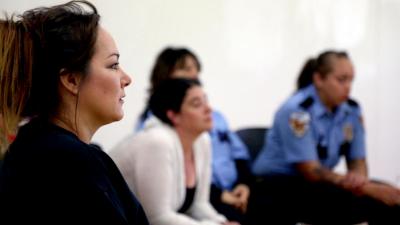 Arming Sisters also focuses on Loreline LaCroix, a freelance advocate working with victims of domestic violence, sexual assault, and sex trafficking. Although she has extensive experience in advocacy, she prefers being outside of the system, working one-on-one with her clients. Comprising one million acres, Fort Berthold is vast, and social services are seriously understaffed; sometimes Loreline is informally commissioned by tribal police officers and advocates to help handle the overflow of victims.
Arming Sisters also focuses on Loreline LaCroix, a freelance advocate working with victims of domestic violence, sexual assault, and sex trafficking. Although she has extensive experience in advocacy, she prefers being outside of the system, working one-on-one with her clients. Comprising one million acres, Fort Berthold is vast, and social services are seriously understaffed; sometimes Loreline is informally commissioned by tribal police officers and advocates to help handle the overflow of victims.
Loreline has a long and traumatic history with assault herself, including being abused at age 2, molested at age 9, raped at age 12, and hospitalized by her first boyfriend and father of her oldest son at age 18. She has been in a stable and healthy marriage for the last 15 years, and views her work with other survivors as a form of restoration.
“I love what I do,” said Loreline. “I’m passionate about working with women…and only women will heal me. This work heals me. And I’ve got a lot of healing to do, so I have a lot of women to help.”
The pervasive violence against Native American women in this country, as witnessed by the subjects of Arming Sisters, is intolerable—yet it has become normalized. The primary goal of the documentary is to raise awareness of the issue and humanize the statistics by sharing the stories of survivors who are actively fighting for positive change. As explained by Lisa Brunner, an advocate for survivors and also one of the subjects of the film, “The first step is for it to be discussed at dinner tables across this country.”
Willow O’Feral and Brad Heck are currently working on editing and raising funds for post-production of Arming Sisters, and they extend their thanks to the Marlboro community for its ongoing support. For more information or to support the film, please visit: www.armingsistersmovie.com.
Direct cinema in a New Jersey free school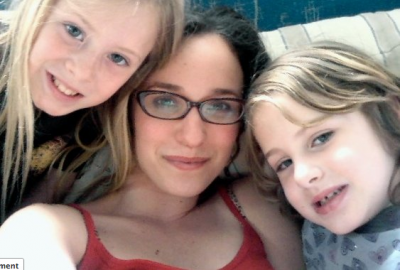 Documentary films bring social issues to life, and for the first feature film of Amanda Wilder ’07 that issue is alternative education. “From the first day at Teddy McArdle Free School I could tell it would be an incredible thing to document, and would fit nicely with the kind of direct cinema I’d grown to love,” says Amanda. “There was a story unfolding before the camera, and a fascinating group of people, most of whom were children.” The resulting film, Approaching the Elephant, poses the vital question of how kids and adults learn to sort things out and live with each other in a school where the youngest student and the school’s director have equal say. In January, Amanda screened Approaching the Elephant at the Latchis Theater, in Brattleboro, and participated in a panel discussion with producer and film professor Jay Craven in New York City.
Documentary films bring social issues to life, and for the first feature film of Amanda Wilder ’07 that issue is alternative education. “From the first day at Teddy McArdle Free School I could tell it would be an incredible thing to document, and would fit nicely with the kind of direct cinema I’d grown to love,” says Amanda. “There was a story unfolding before the camera, and a fascinating group of people, most of whom were children.” The resulting film, Approaching the Elephant, poses the vital question of how kids and adults learn to sort things out and live with each other in a school where the youngest student and the school’s director have equal say. In January, Amanda screened Approaching the Elephant at the Latchis Theater, in Brattleboro, and participated in a panel discussion with producer and film professor Jay Craven in New York City.
Confluence
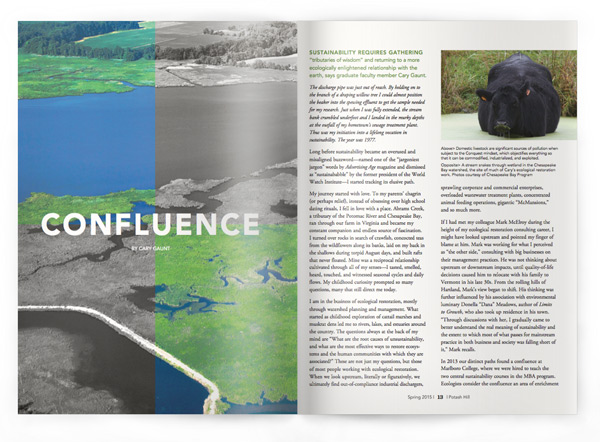
Sustainability requires gathering “tributaries of wisdom” and returning to a more ecologically enlightened relationship with the earth, says graduate faculty member Cary Gaunt.
By Cary Gaunt
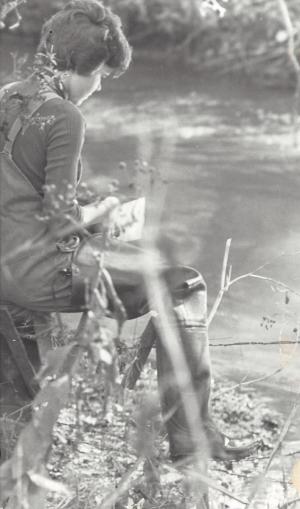 The discharge pipe was just out of reach. By holding on to the branch of a draping willow tree I could almost position the beaker into the spewing effluent to get the sample needed for my research. Just when I was fully extended, the stream bank crumbled underfoot and I landed in the murky depths at the outfall of my hometown’s sewage treatment plant. Thus was my initiation into a lifelong vocation in sustainability. The year was 1977.
The discharge pipe was just out of reach. By holding on to the branch of a draping willow tree I could almost position the beaker into the spewing effluent to get the sample needed for my research. Just when I was fully extended, the stream bank crumbled underfoot and I landed in the murky depths at the outfall of my hometown’s sewage treatment plant. Thus was my initiation into a lifelong vocation in sustainability. The year was 1977.
Long before sustainability became an overused and misaligned buzzword—named one of the “jargoniest jargon” words by Advertising Age magazine and dismissed as “sustainababble” by the former president of the World Watch Institute—I started tracking its elusive path.
My journey started with love. To my parents’ chagrin (or perhaps relief), instead of obsessing over high school dating rituals, I fell in love with a place. Abrams Creek, a tributary of the Potomac River and Chesapeake Bay, ran through our farm in Virginia and became my constant companion and endless source of fascination. I turned over rocks in search of crawfish, concocted teas from the wildflowers along its banks, laid on my back in the shallows during torpid August days, and built rafts that never floated. Mine was a reciprocal relationship cultivated through all of my senses—I tasted, smelled, heard, touched, and witnessed seasonal cycles and daily flows. My childhood curiosity prompted so many questions, many that still direct me today.
I am in the business of ecological restoration, mostly through watershed planning and management. What started as childhood exploration of cattail marshes and muskrat dens led me to rivers, lakes, and estuaries around the country. The questions always at the back of my mind are “What are the root causes of unsustainability, and what are the most effective ways to restore ecosystems and the human communities with which they are associated?” These are not just my questions, but those of most people working with ecological restoration. When we look upstream, literally or figuratively, we ultimately find out-of-compliance industrial dischargers, sprawling corporate and commercial enterprises, overloaded wastewater treatment plants, concentrated animal feeding operations, gigantic “McMansions,” and so much more.
If I had met my colleague Mark McElroy during the height of my ecological restoration consulting career, I might have looked upstream and pointed my finger of blame at him. Mark was working for what I perceived as “the other side,” consulting with big businesses on their management practices. He was not thinking about upstream or downstream impacts, until quality-of-life decisions caused him to relocate with his family to Vermont in his late 30s. From the rolling hills of Hartland, Mark’s view began to shift. His thinking was further influenced by his association with environmental luminary Donella “Dana” Meadows, author of Limits to Growth, who also took up residence in his town. “Through discussions with her, I gradually came to better understand the real meaning of sustainability and the extent to which most of what passes for mainstream practice in both business and society was falling short of it,” Mark recalls.
In 2013 our distinct paths found a confluence at Marlboro College, where we were hired to teach the two central sustainability courses in the MBA program. Ecologists consider the confluence an area of enrichment that occurs at the meeting place of contrasting habitats. When waters from two different sources flow together, for example, the resulting nutrient soup often provides immensely fertile habitat. Wisdom teachers also note the creative ferment of the confluence, or “middle way.”
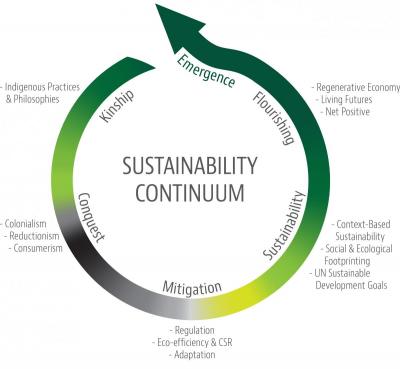 Marlboro is a place imbued with smart and engaged students, who asked for clarity amidst a world of “sustainababble.” From the confluence of our distinct perspectives, and with the skillful facilitation and wisdom of two other colleagues on the MBA faculty, Bill Baue and Pat Daniels, we created the Sustainability Continuum, a business leadership framework that explains the evolution of sustainability and its important normative developments.
Marlboro is a place imbued with smart and engaged students, who asked for clarity amidst a world of “sustainababble.” From the confluence of our distinct perspectives, and with the skillful facilitation and wisdom of two other colleagues on the MBA faculty, Bill Baue and Pat Daniels, we created the Sustainability Continuum, a business leadership framework that explains the evolution of sustainability and its important normative developments.
The Sustainability Continuum identifies six distinct phases of sustainability thought and practice (see figure, right). Although presented as a chronology, we consciously shaped the continuum as a circle to reflect the evolutionary emergence of sustainability consciousness and action, its relationship to ecological cycles and goals of wholeness, and to indicate the actual and desired direction for its unfolding. The trajectory is neither stepwise nor linear. Rather, many of the stages presented in the continuum occur concurrently. Individuals, organizations, and businesses can locate themselves on the continuum and use its framework for sustainability planning and action. It has already proven to be an excellent tool for organizing our curriculum, and teachers throughout the MBA program are using it in their classes.
We initiated the Sustainability Continuum in the deep past, what we call the Kinship stage, where humans were deeply embedded in their places and connected to the natural world in relational and participatory ways, often in accord with ecological cycles. This stage represents an indigenous way of knowing, described by Native American educator and Tewa Indian Gregory Cajete as one that is rooted in place and based on “the perception gained from using the entire body of our senses in direct participation with the natural world.” It is far broader than the narrow view of Western science and business management, because it includes spirituality, community, creativity, and dynamic participation with the natural world based on an ancient covenant. While some have called into question the environmental practices of ancient cultures, indigenous worldviews based on principles of participation, relationship, interdependence, animism, and kinship comprise a “perceptual wisdom” that is essential for sustainability.
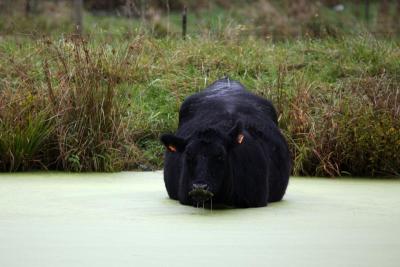 The foundation for many of today’s unsustainable ways surfaced in the Conquest stage, which describes the shift away from interdependence with nature toward exploitation of nature—in which previously sacred relationships became commoditized and privatized, and the natural world became reduced to smaller and smaller parts suitable for study and sale. This period was marked by increased alienation from the natural world, a growing anthropocentric worldview, organized and aggressive colonialism, and the advent of consumerism, including the growth and extractive economies we still have in place today. This is arguably the stage where most businesses and MBA programs focus their emphasis in order to bolster the bottom line and shareholder profits—it is discouraging how many examples of this stage are at work today. We make our students aware of them, but consciously emphasize a new way of doing business.
The foundation for many of today’s unsustainable ways surfaced in the Conquest stage, which describes the shift away from interdependence with nature toward exploitation of nature—in which previously sacred relationships became commoditized and privatized, and the natural world became reduced to smaller and smaller parts suitable for study and sale. This period was marked by increased alienation from the natural world, a growing anthropocentric worldview, organized and aggressive colonialism, and the advent of consumerism, including the growth and extractive economies we still have in place today. This is arguably the stage where most businesses and MBA programs focus their emphasis in order to bolster the bottom line and shareholder profits—it is discouraging how many examples of this stage are at work today. We make our students aware of them, but consciously emphasize a new way of doing business.
One summer day in 1969, an oil slick on the Cuyahoga River began to burn, capturing the attention of a nation waking up to the serious and palpable damages caused by a rampant Conquest stage of human activity. A month later, Neil Armstrong became the first human to set foot on the moon. Images of earth from space showed for the first time the boundaries of a finite planet. The confluence of these memorable events, and many more, sparked the dawn of a formal U.S. environmental movement—on April 22, 1970, the first Earth Day celebration was held, and later that year the Environmental Protection Agency (EPA) was formed.
We mark the Mitigation stage by the establishment of regulatory controls and the rise of eco-efficiency concepts and adaptation initiatives based largely on engineering and other technological approaches. The creation of the EPA was symbolic of this era, and was heralded by a creative burst of environmental regulations—the National Environmental Policy Act, Clean Air Act, Clean Water Act, Ocean Dumping Act, Safe Drinking Water Act, Energy Policy and Conservation Act, Resource Conservation and Recovery Act, Toxic Substances Control Act, and the Superfund Program—all in the first decade.
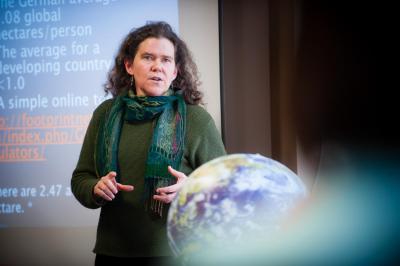 The emphasis of these important efforts was to reduce and/or adapt to the unwanted effects of consumerism by setting limits or increasing efficiency—steps in the right direction, but still not sustainability in the more rigorous sense of the term. My predecessor at Marlboro, sustainability thought leader John Ehrenfeld, sees these efforts as “merely a Band-Aid that masks deeper, cultural roots of our sustainability challenge.” In his seminal book Sustainability by Design, John writes, “Hybrid cars, LED light bulbs, wind farms, and green buildings, these are all just the trappings that convince us that we are doing something when in fact we are fooling ourselves and making things worse.”
The emphasis of these important efforts was to reduce and/or adapt to the unwanted effects of consumerism by setting limits or increasing efficiency—steps in the right direction, but still not sustainability in the more rigorous sense of the term. My predecessor at Marlboro, sustainability thought leader John Ehrenfeld, sees these efforts as “merely a Band-Aid that masks deeper, cultural roots of our sustainability challenge.” In his seminal book Sustainability by Design, John writes, “Hybrid cars, LED light bulbs, wind farms, and green buildings, these are all just the trappings that convince us that we are doing something when in fact we are fooling ourselves and making things worse.”
I have experienced this disconnect between sustainability intention and result throughout my career, most recently as a consultant for the Boston Green Ribbon Commission. I was charged with assessing the progress of the city’s colleges and universities in achieving the ambitious carbon reduction goals of Boston’s Climate Action Plan. All of the schools were taking impressive steps, from building LEED-certified buildings to using sustainable food options for campus dining. Yet all of these were conducted in the shadow of growth. Each university was committed to growing its student population and campus size, effectively overwhelming its positive steps.
Despite decades of well-meaning mitigation efforts, the economics of growth and excess have created conditions where the nation as a whole is not achieving its sustainability goals. Environmental conditions continue to decline, and threats to our natural world appear to be relentless and expanding. People across sectors increasingly ask, “What’s next? How do we respond?” It is from this inquiry that the effort to develop sustainability metrics emerged.
What we call the Sustainability stage responds to the business adage “If you can’t measure it, you can’t manage it.” The Sustainability stage is where business practices revolve around the idea that there are social, economic, and environmental thresholds, locally and globally, that must be taken into account when attempting to manage or assess the effects of human activity. “Authentic sustainability” will only occur when resource use or waste generation are measured against clearly defined place-based limits, such as the amount of water in local aquifers, or the amount of carbon the atmosphere can safely absorb.
 “If you just look at the measurements of what you are doing and don’t tie it back to reality on the ground, in terms of resources that are available or the social investments that are necessary, then you’ve answered some questions,” says Mark McElroy. “But you haven’t answered the question of ‘are you sustainable?’” Mark had started working on measuring sustainability performance with his mentor Dana Meadows shortly before her death in 2001, and he decided to continue this work for his doctoral dissertation. He created a business-focused sustainability accounting system called Context-Based Sustainability (CBS), which has further evolved into the MultiCapital Scorecard (MCS).
“If you just look at the measurements of what you are doing and don’t tie it back to reality on the ground, in terms of resources that are available or the social investments that are necessary, then you’ve answered some questions,” says Mark McElroy. “But you haven’t answered the question of ‘are you sustainable?’” Mark had started working on measuring sustainability performance with his mentor Dana Meadows shortly before her death in 2001, and he decided to continue this work for his doctoral dissertation. He created a business-focused sustainability accounting system called Context-Based Sustainability (CBS), which has further evolved into the MultiCapital Scorecard (MCS).
With Mark’s support, two popular Vermont businesses are stepping out as leaders through their pioneering work implementing these sustainability metrics. Both Cabot Cheese and Ben & Jerry’s are using these approaches to “take sustainability literally,” by exploring actual resources used or impacted in manufacturing, such as water and climate, measured against what is truly available in their manufacturing areas and in their supply chains. In addition, they include a human component and consider factors such as livable wages, social activism, and gender parity.
Sustainability metrics are essential steps in the sustainability journey, yet something else is clearly needed—such was the conclusion of the 2003 Chesapeake Futures report, which provided a 20-year retrospective of restoration efforts and an ambitious look forward. While acknowledging the important contributions of conventional environmental protection approaches, the report concluded that we could not regulate, monitor, measure, or model ourselves out of the problem, or find a technological fix. The report called for the cultivation of a new ethic: the ecologically enlightened citizen.
I became seized by the underlying recommendation of the Futures report, because it captured my own beliefs and the central theme repeatedly heard in sustainability circles—how do we cultivate the ecologically enlightened citizen? It fueled a research inquiry that eventually became my doctoral dissertation and dramatically changed the trajectory of my work. I began shifting my gaze from the Mitigation and Sustainability stages to something much more difficult to quantify. I gathered tributaries of wisdom from sources that were new to me—psychology, religion, spirituality, and other humanities and social sciences—and some that were a homecoming, especially deep exploration of the natural world and contemplative traditions. Even more, I sought out the wisdom of lived experience from individuals who are ecologically awakened and committed to sustainability—leaders and ordinary citizens who modeled the kinds of changes we seek.
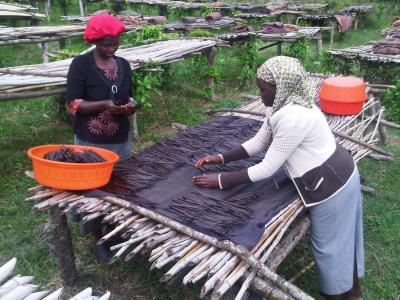 In Sustainability by Design, John Ehrenfeld calls these kinds of changes “sustainability-as-flourishing.” He describes them emerging from profound shifts in human consciousness and behavior, from a view of ourselves of “Having” to one of “Being,” from one of “Needing” to one of “Caring.” The sustainability role models I study for my research embody in many ways the new ethic John imagines. Of course they are intellectually engaged in the issues, from the science of climate change to the complexities of renewable energy. More, however, they speak of creating new stories of how to live and inhabit our places, and how to fit into the larger earth story.
In Sustainability by Design, John Ehrenfeld calls these kinds of changes “sustainability-as-flourishing.” He describes them emerging from profound shifts in human consciousness and behavior, from a view of ourselves of “Having” to one of “Being,” from one of “Needing” to one of “Caring.” The sustainability role models I study for my research embody in many ways the new ethic John imagines. Of course they are intellectually engaged in the issues, from the science of climate change to the complexities of renewable energy. More, however, they speak of creating new stories of how to live and inhabit our places, and how to fit into the larger earth story.
These sustainability role models embody the Flourishing stage by spending time getting to know the resources and beings of their places, using all of their senses. They are gardeners, or participate in ecological restoration. Others are naturalists or artists informed by nature. All are explorers—intellectually curious and wanderers on the land. They use words like beauty, wonder, awe, and love to describe the earth and their relationship to it. Many consider the natural world to be imbued with spirit, and therefore sacred. By being deeply rooted in their places, they intuitively considered environmental and social thresholds in their decision making. They had, whether “born in the groove” like me on the banks of Abrams Creek or “converted later in life” like my colleague Mark McElroy, begun a return to the Kinship stage of sustainability consciousness and action, but with a modern approach.
The Flourishing stage demands a human relationship with place that is premised on reciprocity and embodied through actions that contribute more to the natural and human communities than they take from them. Flourishing enterprises might restore their grounds with locally generated organic compost and bee-friendly native plants, power their buildings with fully renewable resources and give some excess back to the grid, or support every employee’s growth and potential.
Like the Sustainability stage, on-the-ground implementation of the Flourishing stage is in a nascent state, operationalized at a few small, local businesses, farms, and residences, and partially implemented by some large businesses. Widespread implementation has a long way to go, and yet the vision is compelling, necessary, and gaining traction.
Back in 1977, when I plunged into the effluent outfall in Abrams Creek, my hometown sewage plant was a significant polluter—we would place it squarely in the Conquest stage, oblivious to environmental and social concerns. Today, a new facility provides state-of-the-art wastewater treatment and seeks to be an innovative leader in green energy production, processing municipal sludge and organic waste into methane gas. These new ways of doing business demonstrate the Sustainability Continuum in action and provide glimmers of the Flourishing stage that is possible. The great challenge of businesses today— and really the challenge confronting all of us—is not only to comply with natural and human limits, but to consciously improve the systems in which we live and work.
Cary Gaunt has spent most of her career leading watershed restoration efforts around the country for Science Applications International Corporation, and was lucky to spend much of her time working on her home watershed, the Chesapeake Bay. She is now a faculty member in Marlboro’s MBA in Managing for Sustainability program, where she teaches Exploring Sustainability and conducts research on ecologically enlightened leadership and ways businesses can enter the Flourishing stage of the Sustainability Continuum.
Business Doing Good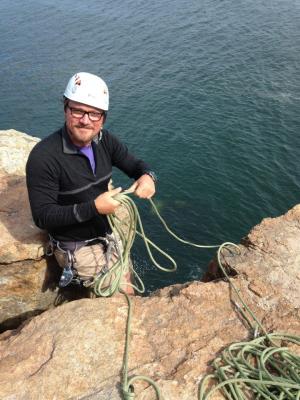 When John Tedesco MBA ’12 was working on his Capstone Project, he was the safety and environmental manager at Green Mountain Power (GMP), where he has worked for nearly 10 years. “I was deeply involved in GMP’s corporate social responsibility reporting (CSR), and I wanted to take our commitment further.” He chose to focus on how GMP could meet the rigorous standards of social and environmental performance, accountability, and transparency spelled out by the nonprofit B Lab. It was therefore gratifying for John when, in December, Green Mountain Power was recognized as the first utility company in the world to become a Certified B Corp. “Regulated monopolies tend to move at a glacial pace when it comes to innovation and forward thinking,” says John. “GMP has shown that you can thrive within the regulated sector and lead the way. Basically it shows the world that all businesses can do good.”
When John Tedesco MBA ’12 was working on his Capstone Project, he was the safety and environmental manager at Green Mountain Power (GMP), where he has worked for nearly 10 years. “I was deeply involved in GMP’s corporate social responsibility reporting (CSR), and I wanted to take our commitment further.” He chose to focus on how GMP could meet the rigorous standards of social and environmental performance, accountability, and transparency spelled out by the nonprofit B Lab. It was therefore gratifying for John when, in December, Green Mountain Power was recognized as the first utility company in the world to become a Certified B Corp. “Regulated monopolies tend to move at a glacial pace when it comes to innovation and forward thinking,” says John. “GMP has shown that you can thrive within the regulated sector and lead the way. Basically it shows the world that all businesses can do good.”
“The world’s harp has but a single string”
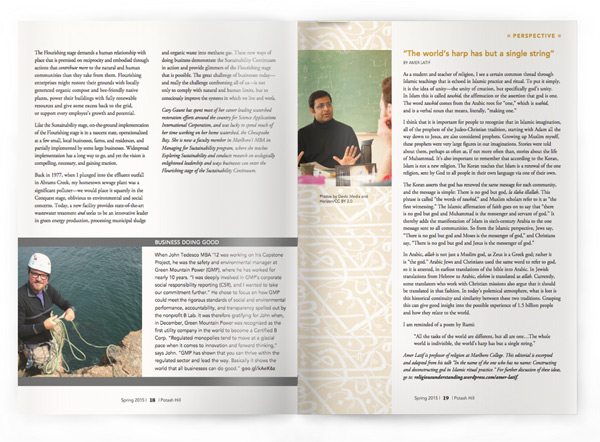
By Amer Latif
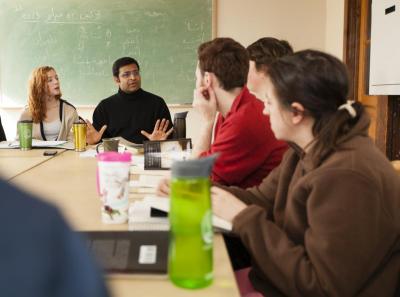 As a student and teacher of religion, I see a certain common thread through Islamic teachings that is echoed in Islamic practice and ritual. To put it simply, it is the idea of unity—the unity of creation, but specifically god’s unity. In Islam this is called tawhid, the affirmation or the assertion that god is one. The word tawhid comes from the Arabic root for “one,” which is wahid, and is a verbal noun that means, literally, “making one.”
As a student and teacher of religion, I see a certain common thread through Islamic teachings that is echoed in Islamic practice and ritual. To put it simply, it is the idea of unity—the unity of creation, but specifically god’s unity. In Islam this is called tawhid, the affirmation or the assertion that god is one. The word tawhid comes from the Arabic root for “one,” which is wahid, and is a verbal noun that means, literally, “making one.”
I think that it is important for people to recognize that in Islamic imagination, all of the prophets of the Judeo-Christian tradition, starting with Adam all the way down to Jesus, are also considered prophets. Growing up Muslim myself, these prophets were very large figures in our imaginations. Stories were told about them, perhaps as often as, if not more often than, stories about the life of Muhammad. It’s also important to remember that according to the Koran, Islam is not a new religion. The Koran teaches that Islam is a renewal of the one religion, sent by God to all people in their own language via one of their own.
The Koran asserts that god has renewed the same message for each community, and the message is simple: There is no god but god, la ilaha illallah. This phrase is called “the words of tawhid,” and Muslim scholars refer to it as “the first witnessing.” The Islamic affirmation of faith goes on to say that “there is no god but god and Muhammad is the messenger and servant of god.” It thereby adds the manifestation of Islam in sixth-century Arabia to the one message sent to all communities. So from the Islamic perspective, Jews say, “There is no god but god and Moses is the messenger of god,” and Christians say, “There is no god but god and Jesus is the messenger of god.”
In Arabic, allah is not just a Muslim god, as Zeus is a Greek god; rather it is “the god.” Arabic Jews and Christians used the same word to refer to god, so it is attested, in earliest translations of the bible into Arabic. In Jewish translations from Hebrew to Arabic, elohim is translated as allah. Currently, some translators who work with Christian missions also argue that it should be translated in that fashion. In today’s polemical atmosphere, what is lost is this historical continuity and similarity between these two traditions. Grasping this can give good insight into the possible experience of 1.5 billion people and how they relate to the world.
I am reminded of a poem by Rumi:
“All the tasks of the world are different, but all are one…The whole world is indivisible, the world’s harp has but a single string.”
Amer Latif is professor of religion at Marlboro College. This editorial is excerpted and adapted from his talk in November titled “In the name of the one who has no name: Constructing and deconstructing god in Islamic ritual practice.” Find further discussion of these ideas.
On & Off the Hill
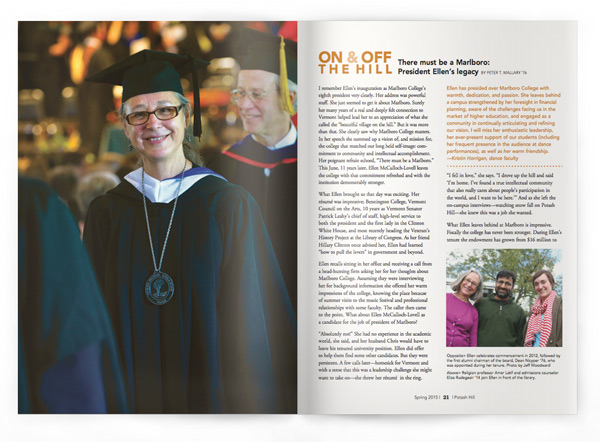
There must be a Marlboro: President Ellen’s legacy
By Peter T. Mallary ’76
I remember Ellen’s inauguration as Marlboro College’s eighth president very clearly. Her address was powerful stuff. She just seemed to get it about Marlboro. Surely her many years of a real and deeply felt connection to Vermont helped lead her to an appreciation of what she called the “beautiful village on the hill.” But it was more than that. She clearly saw why Marlboro College matters. In her speech she summed up a vision of, and mission for, the college that matched our long held self-image: commitment to community and intellectual accomplishment. Her poignant refrain echoed, “There must be a Marlboro.” This June, 11 years later, Ellen McCulloch-Lovell leaves the college with that commitment refreshed and with the institution demonstrably stronger.
What Ellen brought us that day was exciting. Her résumé was impressive; Bennington College, Vermont Council on the Arts, 10 years as Vermont Senator Patrick Leahy’s chief of staff, high-level service to both the president and the first lady in the Clinton White House, and most recently heading the Veteran’s History Project at the Library of Congress. As her friend Hillary Clinton once advised her, Ellen had learned “how to pull the levers” in government and beyond.
Ellen recalls sitting in her office and receiving a call from a head-hunting firm asking her for her thoughts about Marlboro College. Assuming they were interviewing her for background information she offered her warm impressions of the college, knowing the place because of summer visits to the music festival and professional relationships with some faculty. The caller then came to the point. What about Ellen McCulloch-Lovell as a candidate for the job of president of Marlboro?
“Absolutely not!” She had no experience in the academic world, she said, and her husband Chris would have to leave his tenured university position. Ellen did offer to help them find some other candidates. But they were persistent. A few calls later—homesick for Vermont and with a sense that this was a leadership challenge she might want to take on—she threw her résumé in the ring.
Ellen has presided over Marlboro College with warmth, dedication, and passion. She leaves behind a campus strengthened by her foresight in financial planning, aware of the challenges facing us in the market of higher education, and engaged as a community in continually articulating and refining our vision. I will miss her enthusiastic leadership, her ever-present support of our students (including her frequent presence in the audience at dance performances), as well as her warm friendship.
—Kristin Horrigan, dance faculty
“I fell in love,” she says. “I drove up the hill and said ‘I’m home. I’ve found a true intellectual community that also really cares about people’s participation in the world, and I want to be here.’” And as she left the on-campus interviews—watching snow fall on Potash Hill—she knew this was a job she wanted.
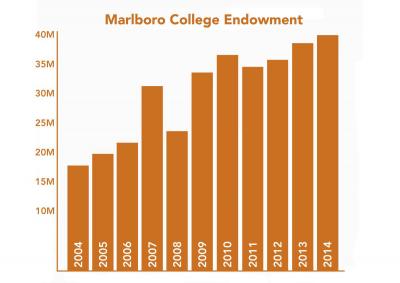 What Ellen leaves behind at Marlboro is impressive. Fiscally the college has never been stronger. During Ellen’s tenure the endowment has grown from $16 million to more than $40 million (see chart right). The endowment per student meets the highest national standards. It also leaves the college with the ability to commit substantial resources to broadcasting Marlboro’s unique story far afield. All this has been accomplished in spite of international economic trauma. Though she is quick to give her predecessors credit for building an endowment foundation, there is no question that this president has brought special skills to the art of donor relations and fundraising in general. She has a gift for telling the college’s story—and convincing people that they want to be a part of that story.
What Ellen leaves behind at Marlboro is impressive. Fiscally the college has never been stronger. During Ellen’s tenure the endowment has grown from $16 million to more than $40 million (see chart right). The endowment per student meets the highest national standards. It also leaves the college with the ability to commit substantial resources to broadcasting Marlboro’s unique story far afield. All this has been accomplished in spite of international economic trauma. Though she is quick to give her predecessors credit for building an endowment foundation, there is no question that this president has brought special skills to the art of donor relations and fundraising in general. She has a gift for telling the college’s story—and convincing people that they want to be a part of that story.
I knew from the start that Ellen would bring uncommon grace, clarity, and collegiality to Marlboro. Throughout, she has been a champion of the college and a true friend to the community, near and far, celebrating with us our core mission and accomplishments and inspiring confidence in Marlboro’s future.
—Jim Tober, retired economics faculty
Academically, as well, the college has never been stronger. When Ellen arrived, she saw a number of challenges. A generation of senior faculty was about to retire without a proper retirement program in place. There was also a need to increase faculty salaries. So she raised $12 million to endow the Fund for Inspired Teaching, designed to address these issues. And new faculty came, mentored by long-serving faculty and staff.
“We have very strong new faculty who are really embracing the Marlboro model of student-driven learning and working across disciplines. When a faculty member says—as they typically do at Marlboro—‘my students are my colleagues,’ that’s very unusual in higher education. They set very high expectations that students want to meet. We have to continue to advocate for and explain our model; we open students’ minds to other ways of learning and the expanse of discovery.” As she leaves, Ellen is establishing the President’s Fund for Marlboro’s Future in order to further recognize and endow the faculty and staff’s commitment to the Marlboro model— personal, intensive, and demanding.
The future of the graduate and professional studies program has been a particular focus of Ellen’s, as she worked to build a bridge between the graduate and undergraduate campuses both practically and philosophically. She launched the program in nonprofit management, which now includes certificate and master’s programs, leadership and board training.
For me, Ellen’s legacy will be the many instances over the past ten years where she modeled a remarkable ability for deep listening and attentiveness to the many different and, at times, competing voices within our community.
—Amer Latif, religion faculty
“The graduate center provides a way to expand our offerings for working adults, using a hybrid model that blends intensive, in-person residency with online learning. The programs have evolved closer to the heart of the college on the hill: we are one college serving many kinds of students.” A growing number of undergraduate students have gone on to earn professional certificates or master’s degrees through the graduate and professional studies programs. “It has also been a great opportunity for a higher profile in the region.”
Ellen talks about some of the things that surprised her about the job. One has been her interest in the physical plant and the appearance of the campus, both on the hill and downtown.
“One of the things people always remark about Marlboro College is that it is beautiful. I often describe it as a New England hill village. It’s an apt metaphor, with our Town Meeting and our smallness and our interdependence. It goes to the core of Marlboro’s identity. It has given me very deep pleasure to make it more beautiful.”
Remarkable strides have been made in the past decade. Early in her tenure, Ellen had the pleasure of presiding over the dedication of the Serkin Center for the Performing Arts. In 2006 the Gib Taylor metalworking studio opened, and in 2008 the Total Health Center. In 2011 the core of the campus received a landscaping makeover, and in 2012 the community greenhouse opened, followed by new classroom spaces downtown.
Ellen has added 114 acres and two other buildings to the undergraduate campus in her time here. As she prepares to leave, ground has been broken for the Snyder Center for the Visual Arts, scheduled to open this fall. Her personal vision and fundraising fingerprints are all over most of these projects—just further examples of the network of support for the college that she has built, with “lots of help from others.” Those others include the Marlboro Music School and Festival, based on the undergraduate campus in the summer, a relationship that Ellen has treasured.
Another surprise Ellen notes is how much she came to care about the students, and how much she worried about them.
“I didn’t realize how powerful it would be, watching their struggles and their triumphs. I can’t keep them safe, and I can’t make sure they always make the right decisions, but I want them to have the tools to make good decisions and to have good lives.”
My fondest memories are of Ellen’s personal commitment to Marlboro—a kind word in times of joy and sorrow, her gracious presence in a senior oral, and her ready acceptance of my spontaneous request to read a poem in an Environmental Studies class session for accepted students.
—Jenny Ramstetter, biology faculty
There have been storms to weather—literally. Ellen recalls the night of the 2008 ice storm, when the woods around the president’s house rang with cracks that “sounded like rifles” as trees and limbs fell. That morning Ellen was one of just a few people able to get to campus. She opened the kitchen and ended up flipping pancakes, enlisting students to help.
“We were two and a half days with no power. Nearby faculty and staff walked to campus to help. Dan Cotter and his crew moved generators from building to building.” Ellen recalls the resilience of the students as the power outages went on, finally leading to their being sent home early for the December holidays.
Following that storm, a generous donor provided funds for a generator to cover parts of the center of campus, and Ellen would need it. In 2011 Tropical Storm Irene brought high winds and rain—11 inches in 24 hours. Roads washed out, and the campus was cut off for three days.
“We had new students back from their Bridges orientation trips. The sense of isolation was really extreme. Keeping everybody fed was a challenge. But the community was once again resilient. We ate a lot of rice and beans.”
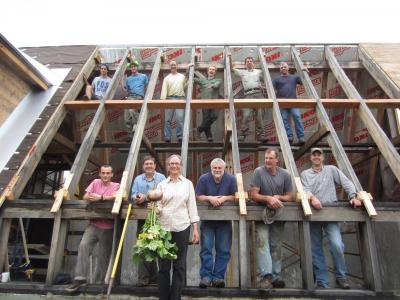
Ellen has taken an active interest in every area of the college: all of its curriculum, all of the many faculty and staff hires, its alumni, friends, and donors, the Outdoor Program, Town Meeting, long range planning, and current culture. The energy she has brought to all of this is humbling not just because of how hard it is but because of the sincerity of her concern for all these activities and constituencies.
—Tim Segar, visual arts faculty
Ellen has tackled other crises as well. Perhaps most importantly she has become a national champion of the liberal arts, seeking and achieving a high profile concerning the widespread challenge to what one faculty member calls “the liberating arts.” There has been a lot of debate and a lot of pressure from the White House on down, especially now with greater vocational focus and the monetization of the value of higher education.
“It can be very hard to struggle against the trend—to stand up for liberal education, the broad knowledge and academic skills that the Plan of Concentration is all about. How do we adapt, and how do we fight? How do we continue to present our strengths? I am committed more strongly than ever to finding these answers. I believe in a liberal arts education more fervently than when I wrote that inaugural address. I’m lucky to have the support of trustees who share that belief.”
Ellen chastises herself for not seeing emerging enrollment challenges coming sooner. But she extolls the virtue of collaborations with faculty, staff, students, and trustees to meet these challenges. “A wonderful we,” she says. “Everything I’ve been able to do was with the support of others.” Mostly, she seems at peace with her tenure and a bit nostalgic as she contemplates finishing up.
“I don’t think I fully realized the great pleasures of being part of an intellectual and creative community,” she says. “I will remember moments like giving graduate students diplomas while their children cheer them on, or a recent Work Day spent cleaning up the campus while students talked about their interpretation of Dostoyevsky. It’s a very heady place.”
From the final phrases of Ellen’s inaugural address comes her vision of Marlboro writ simple and clear: “There must be a Marlboro: a place of beauty; a clearing in the forest made for contemplation; a space to create and to become.” Ellen McCulloch-Lovell has made another generation of this dream possible.
Peter Mallary is a Marlboro trustee and the father of a graduate, Rebecca Mallary ’11.
I have had the pleasure of working with Ellen on everything from grant writing to revisiting the role of the dean of faculty. In every instance I have found her wise, compassionate, and creative. Each spring at commencement, Ellen greets every graduating senior as they cross the stage—what may not be visible from down on the floor is her connection to every one of those 70-odd students. This connection is an expression of her grace and warmth, qualities so intrinsic to her demeanor that it is virtually impossible to imagine her without them.
—Seth Harter, Asian studies faculty
Eleven Years with Ellen
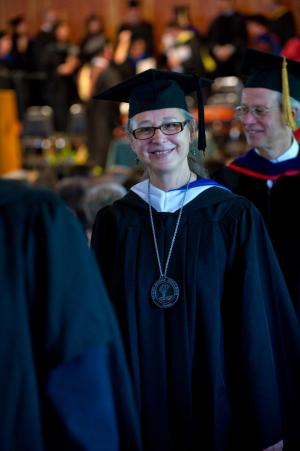 2004
2004
- Inauguration as eighth president of Marlboro College
- Bart Goodwin becomes chairman of board
2005
- Marlboro ranked #1 by Princeton Review for “Professors Bring Material to Life”
- Jerome I. Aron Fund established to support student-faculty collaboration
- Ellen works with community to articulate Four Goals to Guide Marlboro
- Dedication of Serkin Center for the Performing Arts
- Chris Lovell starts Community Trails Day to maintain OP trails
2006
- Dedication of Gib Taylor metalworking studio
- Center for Creative Solutions established to respond to community planning needs
2007
- Marlboro MBA in Managing for Sustainability launched
- 60th Anniversary Fund for Inspired Teaching created
2008
- Grand opening of Total Health Center
- Bridges orientation programs for new students established
- Dedication of Gander Center for World Studies
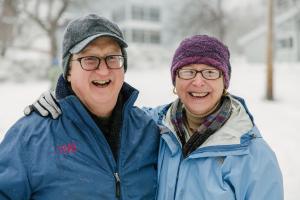 2009
2009
- Marlboro rides out economic storm
- College launches energy efficiency measures with U.S. Department of Energy grant
2010
- Task Force on the Future makes recommendations
- First alumnus board chair, Dean Nicyper ‘76
- Graduate school launches program in nonprofit management
2011
- Center of campus upgraded with walking paths and stone walls
- Marlboro rises to challenge of Tropical Storm Irene
- Global opportunities supported by Christian A. Johnson Endeavor Foundation
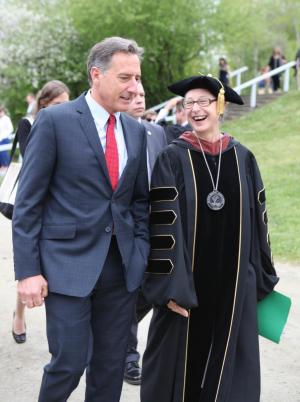 Marlboro offers dual degree programs through graduate school
Marlboro offers dual degree programs through graduate school- Summer programs for high school students launched
- Margaret A. Cargill Foundation grant supports environmental initiatives
2012
- Movies from Marlboro launched
- Community greenhouse grand opening
2013
- Beautiful Minds Challenge established
2014
- Strategic Plan for Marlboro’s future approved by trustees
- Snyder Center for the Visual Arts groundbreaking
- Cottages renovated with Marlboro Music School
John Rush animates economics
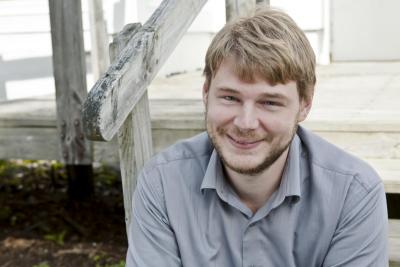 “I wanted to be somewhere where teaching would be valued, and to really have the opportunity to know my students,” says John Rush, a professor of economics who joined the Marlboro faculty in August. Before coming to Marlboro, John taught at the University of Hawaii, where he had more than a hundred students in one class and found it hard to make a significant connection with them. He is excited to be at Marlboro, which he considers “an ideal place to be a teacher and to work with students.”
“I wanted to be somewhere where teaching would be valued, and to really have the opportunity to know my students,” says John Rush, a professor of economics who joined the Marlboro faculty in August. Before coming to Marlboro, John taught at the University of Hawaii, where he had more than a hundred students in one class and found it hard to make a significant connection with them. He is excited to be at Marlboro, which he considers “an ideal place to be a teacher and to work with students.”
John grew up in northern California and received his bachelor’s degree in economics and a master’s in management from Whitworth University, in Spokane, Washington. He then went on to get his M.A. and Ph.D. in economics at the University of Hawaii at Manoa, where he researched the influence of natural disasters on poverty and inequality in developing countries.
“I have a lot of interests,” says John. “My research up to now has been focused on natural disasters and how they affect economic development, but I’ve also been really interested in the history of economic thought, learning more about the originators of the big ideas we use in economics. Gold rushes are something I’ve studied a little bit about and find really interesting to look at from an economic perspective.” He also wants to further explore the philosophical concept of “weakness of will,” a subject he finds very relevant to the foundations of economic theory.
John finds that his research helps inform his teaching in many ways, whether that’s using natural disasters to help illustrate economic ideas in a vivid and accessible way, or reading broadly to explore new connections with other disciplines. He has taught economics at the University of Hawaii, Kapiolani Community College, and LCC International University in Lithuania, but finds Marlboro especially conducive to his interdisciplinary leanings.
“One of the things I like about Marlboro is that I can read things that I wouldn’t necessarily be justified in reading for my job at other places,” he says. “There are many kinds of questions related to economics that have to do with assumptions and individual choice. At Marlboro I am free to explore these ideas without having to lay out a clear research agenda, and I think it helps my teaching. I am more informed about things that are interesting to me and important for students to think about.”
John taught two classes last fall, International Economics and Economics: Principles and Problems, the latter of which included Robinson Crusoe on the reading list. Although he asserts that economists have used Daniel Defoe’s classic to illustrate certain principles for centuries, it is less common to include the novel in an economics class, as he does. In his class on economic development he includes Mark Twain’s Connecticut Yankee in King Arthur’s Court. “That one was more my own idea,” he says. “I think it is a really excellent novel in terms of development and ethics.”
John cites Scottish philosopher Adam Smith as one of the authors that has most influenced his thoughts, not only his famous Wealth of Nations, but also The Theory of Moral Sentiments. “This much smaller book gives you a good background and understanding of where Adam Smith is coming from, in terms of what he believes about people and about the nature of human beings. It provides an interesting context to his other economics work.”
He is excited about building on the economics curriculum at Marlboro, so ably guided by retired professor Jim Tober since its inception. For John it is an opportunity to think about economics in a different way, in a broader and more interdisciplinary context, and to create a program that is responsive to the interests of students. He finds the small classes and close collaborative relationships with students at Marlboro a huge advantage in this regard.
“You can tailor classes if students are interested in a particular thing—when it’s a huge class it’s harder to do that because everyone is interested in a lot of different things,” he says. “Also, I can keep better track of my students—I can notice early on if someone is struggling. It’s much easier to be proactive if you have a relationship with students.” In economic terms, which are only fitting, John finds that Marlboro’s faculty-student ratio has a direct impact on the “marginal product.” “The quality of economic knowledge I can produce per student in a small class is larger than what I could produce for a student in a large class.”
Watch the next Potash Hill for a profile of Jean O’Hara, a new faculty member in theater who joins us on campus this spring semester.
EEI brings environmental leadership on the road
“Marlboro College has remarkable and deep roots in Vermont,” says Kyhl Lyndgaard, professor of writing and director of environmental studies at Marlboro. “But to paraphrase nature writer John Daniel, we can also say words in favor of rootlessness, at least in the form of a semester on a bus.”
Kyhl was referring to Marlboro’s new partnership with the Expedition Education Institute (EEI) to adopt innovative, bus-based programs pioneered by EEI into Semester at Marlboro offerings. Together, the two organizations will provide an undergraduate and gap-year pilot semester in the fall of 2015, and are in discussion about the possible launch of a new Master of Arts in Teaching for Ecological Education and Leadership.
EEI comes from more than 40 years of higher education rooted in direct experience, independent learning, and immersion in the natural world, as practiced by the former Audubon Expedition Institute. Participants live and learn together in an experiential learning community, traveling in a custom-retrofitted school bus. Students and faculty eat, sleep, and study outdoors within a specific bioregion as they explore local and global environmental challenges faced by communities and ecosystems.
“EEI is entirely field based but still interdisciplinary, which is a hallmark of environmental studies at Marlboro,” says Kyhl, who points out that with many alumni common to EEI and Marlboro, the fit was clear even before the partnership became official. “EEI allows for the experiential and self-directed learning that has long been central to the Marlboro model, but is mobile.”
The fall 2015 semester will take place in the Adirondacks and Appalachia, with a focus on energy and climate justice, and will be open to gap-year students, Marlboro College students, and visiting undergraduate students from other institutions. Spring 2016 will find the bus in the southeastern states, with a focus on sustainable food and farming. For more information, go to: marlboro.edu/getonthebus.
College digs in for new arts space
A lively crowd gathered at the ceremonial groundbreaking for the college’s new Snyder Center for the Visual Arts, a 14,000-square-foot building that will be built adjacent to existing visual arts buildings. The groundbreaking and reception on December 5 kicked off a full weekend Winter Arts Festival that included open studios, demonstrations, dance recitals, a play, and a chamber music concert.
A quarter of all Marlboro students include visual arts as part of their Plan of Concentration. The goal of the visual arts center is to make classroom and studio spaces more integrated and healthy, and to allow for a more flexible pedagogy that integrates other disciplines.
“This arts facility will provide a new creative space for all, and will welcome faculty in other disciplines to use it, hold classes, display work, and collaborate with faculty in the arts,” says President Ellen McCulloch-Lovell. “It will support the college’s mission of intellectual and artistic creativity.”
The new building will provide a more concentrated space for the ceramics program, which is now spread between two buildings, and a digital media lab, which is currently housed in the library. By its 2015 completion, the visual arts center will also include classrooms, a gallery space, student studios, a sculpture studio, and a welding area.
Also of Note
 “Experience showed that serious art-making and reflection on those processes engaged students, gave teachers new tools, transferred interest from one subject to another, enlivened the school day, and kept students in school,” said President Ellen McCulloch-Lovell. Ellen gave the keynote address at a summit titled “Envisioning Arts Education in Vermont,” hosted by the Vermont Arts Council (VAC) in September. Ellen related some of her own experiences proposing and promoting arts policy in Vermont and nationally, including founding the Governor’s Institutes, which began with the arts, and directing President Clinton’s Committee on the Arts and the Humanities.
“Experience showed that serious art-making and reflection on those processes engaged students, gave teachers new tools, transferred interest from one subject to another, enlivened the school day, and kept students in school,” said President Ellen McCulloch-Lovell. Ellen gave the keynote address at a summit titled “Envisioning Arts Education in Vermont,” hosted by the Vermont Arts Council (VAC) in September. Ellen related some of her own experiences proposing and promoting arts policy in Vermont and nationally, including founding the Governor’s Institutes, which began with the arts, and directing President Clinton’s Committee on the Arts and the Humanities.
Junior Edward Suprenant spent the summer in Nepal studying Buddhist philosophy at the Rangjung Yeshe Institute, through a partnership between Kathmandu University and the Tulku Urgyen monastery. “The focus of my stay was to hopefully loosen any myopic conceptions of Buddhism I may have gained through my previous studies,” says Edward, who studied Zen Buddhism at a monastery in San Francisco. “I got exposed to a lot of South Asian cultural aspects I wasn’t aware of. Being in that environment and studying the things that come from that social environment was really cool.”
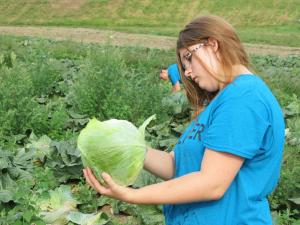 “In the workplace, love can exist with those who are willing to lay aside ego, let their guard down, and explore their struggles together,” says Jodi Clark ’95, former director of housing. “With extra wisdom and trust brought to a particular problem, they may also discover that a powerful resource for fueling their work is their love and care for each other.” Jodi was the subject of a blog on JustMeans.com by Julie Fahnestock MBA ’14, titled “Is Love in the Workplace the New Norm?” .
“In the workplace, love can exist with those who are willing to lay aside ego, let their guard down, and explore their struggles together,” says Jodi Clark ’95, former director of housing. “With extra wisdom and trust brought to a particular problem, they may also discover that a powerful resource for fueling their work is their love and care for each other.” Jodi was the subject of a blog on JustMeans.com by Julie Fahnestock MBA ’14, titled “Is Love in the Workplace the New Norm?” .
Photography student Julian Harris ’14 had photos published in Living on Earth, Public Radio International’s environmental news magazine, in October. His striking images of traditional tanneries in Morocco were the result of a research project he did there during a program through the School for International Training (SIT), in collaboration with a fellow SIT student. The article focuses on the toxic chemicals used in traditional tanneries, which can result in serious health and environmental problems.
Hillary Boone MSM-MDO ’14, nonprofit programs communications coordinator, joined fellow Vermonters Senator Diane Snelling and Scott Johnson of the Lamoille Family Center at the RBA Africa Summit, held in Johannesburg, South Africa, in October. There, Hillary presented a session titled “Lessons Learned in Large Scale RBA (results-based accountability) Roll-out and Implementation.” In addition to handling communication for nonprofit programs at Marlboro, Hillary is program manager and RBA coach for Benchmarks for a Better Vermont, a federally funded initiative to integrate performance measurement systems in Vermont nonprofits.
 Claire Maleney ’15 (right) spent last spring semester in Switzerland, where she was studying with a School for International Training program titled International Studies and Multilateral Diplomacy. She focused on the International Criminal Court, but the highlight for her was traveling around Europe afterwards. “In many ways I think it has given me a clearer perspective on international relations,” she says, “and certainly a better understanding of how the history I’ve learned about plays out today.”
Claire Maleney ’15 (right) spent last spring semester in Switzerland, where she was studying with a School for International Training program titled International Studies and Multilateral Diplomacy. She focused on the International Criminal Court, but the highlight for her was traveling around Europe afterwards. “In many ways I think it has given me a clearer perspective on international relations,” she says, “and certainly a better understanding of how the history I’ve learned about plays out today.”
Events
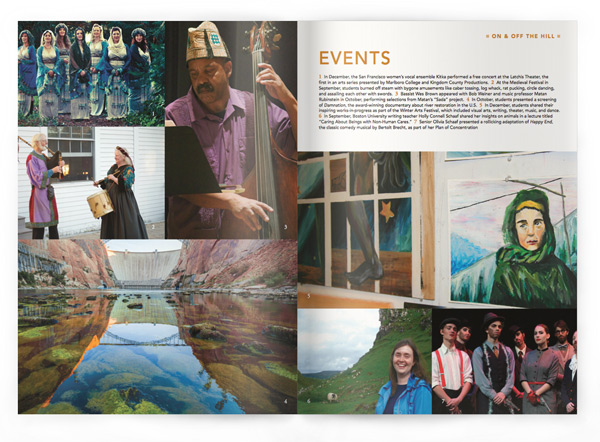
1 In December, the San Francisco women’s vocal ensemble Kitka performed a free concert at the Latchis Theater, the first in an arts series presented by Marlboro College and Kingdom County Productions. 2 At the Medieval Festival in September, students burned off steam with bygone amusements like caber tossing, log whack, rat pucking, circle dancing, and assailing each other with swords. 3 Bassist Wes Brown appeared with Bob Weiner and music professor Matan Rubinstein in October, performing selections from Matan’s “Sada” project. 4 In October, students presented a screening of Damnation, the award-winning documentary about river restoration in the U.S. 5 In December, students shared their inspiring works-in-progress as part of the Winter Arts Festival, which included visual arts, writing, theater, music, and dance. 6 In September, Boston University writing teacher Holly Connell Schaaf shared her insights on animals in a lecture titled “Caring About Beings with Non-Human Cares.” 7 Senior Olivia Schaaf presented a rollicking adaptation of Happy End, the classic comedy musical by Bertolt Brecht, as part of her Plan of Concentration
Focus on Faculty
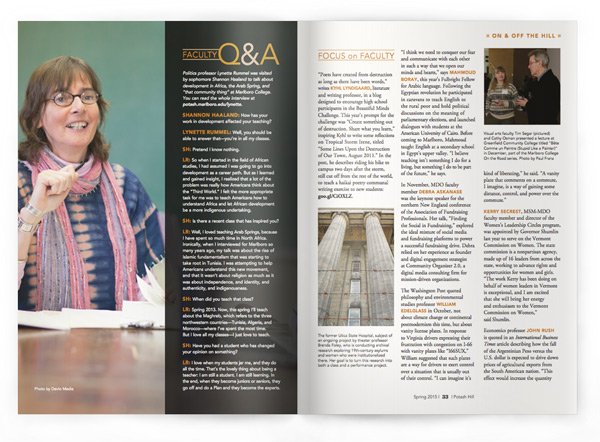
Faculty Q&A
Politics professor Lynette Rummel was visited by sophomore Shannon Haaland to talk about development in Africa, the Arab Spring, and “that community thing” at Marlboro College. You can read the whole interview.
Shannon Haaland: How has your work in development affected your teaching?
Lynette Rummel: Well, you should be able to answer that—you’re in all my classes.
SH: Pretend I know nothing.
LR: So when I started in the field of African studies, I had assumed I was going to go into development as a career path. But as I learned and gained insight, I realized that a lot of the problem was really how Americans think about the “Third World.” I felt the more appropriate task for me was to teach Americans how to understand Africa and let African development be a more indigenous undertaking.
SH: Is there a recent class that has inspired you?
LR: Well, I loved teaching Arab Springs, because I have spent so much time in North Africa. Ironically, when I interviewed for Marlboro so many years ago, my talk was about the rise of Islamic fundamentalism that was starting to take root in Tunisia. I was attempting to help Americans understand this new movement, and that it wasn’t about religion as much as it was about independence, and identity, and authenticity, and indigenousness.
SH: When did you teach that class?
LR: Spring 2013. Now, this spring I’ll teach about the Maghreb, which refers to the three northwestern countries—Tunisia, Algeria, and Morocco—where I’ve spent the most time. But I love all my classes—I just love to teach.
SH: Have you had a student who has changed your opinion on something?
LR: I love when my students jar me, and they do all the time. That’s the lovely thing about being a teacher: I am still a student. I am still learning. In the end, when they become juniors or seniors, they go off and do a Plan and they become the experts.
Focus on Faculty
“Poets have created from destruction as long as there have been words,” writes Kyhl Lyndgaard, literature and writing professor, in a blog designed to encourage high school participants in the Beautiful Minds Challenge. This year’s prompt for the challenge was “Create something out of destruction. Share what you learn,” inspiring Kyhl to write some reflections on Tropical Storm Irene, titled “Some Lines Upon the Destruction of Our Town, August 2011.” In the post, he describes riding his bike to campus two days after the storm, still cut off from the rest of the world, to teach a haikai poetry communal writing exercise to new students.
“I think we need to conquer our fear and communicate with each other in such a way that we open our minds and hearts,” says Mahmoud Boray, this year’s Fulbright Fellow for Arabic language. Following the Egyptian revolution he participated in caravans to teach English to the rural poor and hold political discussions on the meaning of parliamentary elections, and launched dialogues with students at the American University of Cairo. Before coming to Marlboro, Mahmoud taught English at a secondary school in Egypt’s upper valley. “I believe teaching isn’t something I do for a living, but something I do to be part of the future,” he says.
In November, MDO faculty member Debra Askanase was the keynote speaker for the northern New England conference of the Association of Fundraising Professionals. Her talk, “Finding the Social in Fundraising,” explored the ideal mixture of social media and fundraising platforms to power a successful fundraising drive. Debra relied on her experience as founder and digital engagement strategist at Community Organizer 2.0, a digital media consulting firm for mission-driven organizations.
 The Washington Post quoted philosophy and environmental studies professor William Edelglass in October, not about climate change or continental postmodernism this time, but about vanity license plates. In response to Virginia drivers expressing their frustration with congestion on I-66 with vanity plates like “I66SUX,” William suggested that such plates are a way for drivers to exert control over a situation that is usually out of their control. “I can imagine it’s kind of liberating,” he said. “A vanity plate that comments on a commute, I imagine, is a way of gaining some distance, control, and power over the commute.”
The Washington Post quoted philosophy and environmental studies professor William Edelglass in October, not about climate change or continental postmodernism this time, but about vanity license plates. In response to Virginia drivers expressing their frustration with congestion on I-66 with vanity plates like “I66SUX,” William suggested that such plates are a way for drivers to exert control over a situation that is usually out of their control. “I can imagine it’s kind of liberating,” he said. “A vanity plate that comments on a commute, I imagine, is a way of gaining some distance, control, and power over the commute.”
Kerry Secrest, MSM-MDO faculty member and director of the Women’s Leadership Circles program, was appointed by Governor Shumlin last year to serve on the Vermont Commission on Women. The state commission is a nonpartisan agency, made up of 16 leaders from across the state, working to advance rights and opportunities for women and girls. “The work Kerry has been doing on behalf of women leaders in Vermont is exceptional, and I am excited that she will bring her energy and enthusiasm to the Vermont Commission on Women,” said Shumlin.
Economics professor John Rush, is quoted in an International Business Times article describing how the fall of the Argentinian Peso versus the U.S. dollar is expected to drive down prices of agricultural exports from the South American nation. “This effect would increase the quantity of Argentine agricultural products demanded in the United States, benefiting agricultural exporters in Argentina,” says John. According to the article, the lower price for Argentine agricultural products in the global market could prove to be a boon for the nation’s farmers, ranchers, and other exporters.
Spanish language and literature professor Rosario de Swanson's poetry was featured in a recent anthology on immigration and borderlands titled Déjame que te cuente…, Volume III, Bilingual Edition. The volume was published in 2014 by Chiringa Press, in Seguin, Texas. “My work includes selections from a collection titled De canciones de amor y otras penas, and within this a poem about crisis on the border simply titled “Plegaria a la humanidad,” or “Plea to humanity.”
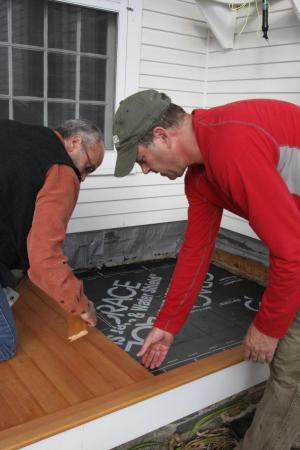 “Maybe once we accept that colleges cannot out-perform the criminal justice system, permission will be granted to try something that actually draws on our strengths,” wrote politics professor Meg Mott in the Washington Post in July. In response to new legislation aimed at curbing sexual assaults on college campuses by forcing colleges to be more accountable in their disciplinary proceedings, Meg argued that many cases would be better served by mediation. “We are so much better at creating the conditions where young people can learn from their mistakes than pretending we can fight crime like the professionals,” she wrote: goo.gl/0GsRvJ.
“Maybe once we accept that colleges cannot out-perform the criminal justice system, permission will be granted to try something that actually draws on our strengths,” wrote politics professor Meg Mott in the Washington Post in July. In response to new legislation aimed at curbing sexual assaults on college campuses by forcing colleges to be more accountable in their disciplinary proceedings, Meg argued that many cases would be better served by mediation. “We are so much better at creating the conditions where young people can learn from their mistakes than pretending we can fight crime like the professionals,” she wrote: goo.gl/0GsRvJ.
Marlboro College was pleased to present the world premier of Vermont Headstones, a set of songs for oboe, viola, and baritone composed by music professor Stan Charkey, as part of the Music for a Sunday Afternoon series in November. The new work was based on headstone inscriptions found in cemeteries throughout Vermont, from Marlboro to Mt. Holly, from the 18th and early 19th centuries. Vermont Headstones was performed by three colleagues from the University of Maryland School of Music, Daren Jackson (baritone), Mark Hill (oboe), and Katherine Murdock (viola).
“TV series are increasingly challenging the dominant position of feature-length film in Africa,” writes French language professor Boukary Sawadogo in the Canadian film journal CineAction. In an article titled “Are Sitcoms the Future of Francophone West African Cinema?” Boukary examines the changing landscape of West African films in light of the ever-growing production, popularity, and accessibility of locally produced TV series. “Sitcoms are creating a new dynamic in African cinemas, with regard to accessibility and delivery that are enhanced and democratized by the development of digital technologies,” he writes.
In September, MSM-MDO Program Chair Kate Jellema and Hillary Boone, nonprofit programs communications coordinator, led sessions at the annual conference of the Alliance for Nonprofit Management, in Austin, Texas. “We came back invigorated by new ideas, but also excited about Vermont’s leadership in fields like results-based accountability, learning communities, and personal leadership development,” says Kate.
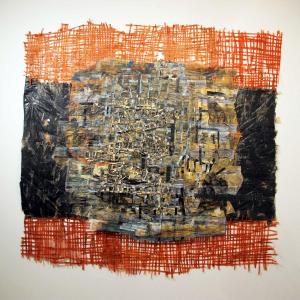 In January, film professor Jay Craven presented a panel discussion in New York titled “Outside Manhattan: John Dewey’s Case for Intensive Learning and Cultural Cinema,” the latest in the Marlboro College On the Road series. He was joined by alumni Jesse Nesser ’13 and Amanda Wilder ’07, both accomplished filmmakers, in an informal talk at one of New York’s premier performance venues, The Cutting Room, owned by Marlboro alumnus Chris Noth. Jay shared anecdotes from his experiences with the Movies from Marlboro program, demonstrating John Dewey’s call for “intensive learning that enlarges meaning through the shared experience of joint action.”
In January, film professor Jay Craven presented a panel discussion in New York titled “Outside Manhattan: John Dewey’s Case for Intensive Learning and Cultural Cinema,” the latest in the Marlboro College On the Road series. He was joined by alumni Jesse Nesser ’13 and Amanda Wilder ’07, both accomplished filmmakers, in an informal talk at one of New York’s premier performance venues, The Cutting Room, owned by Marlboro alumnus Chris Noth. Jay shared anecdotes from his experiences with the Movies from Marlboro program, demonstrating John Dewey’s call for “intensive learning that enlarges meaning through the shared experience of joint action.”
In August, visual arts faculty member Cathy Osman was awarded a Vermont Arts Council “creation grant” to support the creation of a body of work addressing the multifaceted relationship between the U.S. and Cambodia. Cathy has helped lead service-learning trips to Cambodia three times in the last five years, and her recent collage-based work suggests the impact of modernization and the English-speaking world upon the Southeast Asian nation. “This new body of work will continue to reflect on my relationship to my service work in Cambodia and what it means to engage in a culture that is dramatically modernizing, debilitatingly poor, historically scarred, yet resilient,” says Cathy.
“Unlike any other system for assessing the sustainability performance of a company, the MultiCapital Scorecard (MCS) makes it possible to answer the questions all organizations should be asking of themselves,” says Mark McElroy, Marlboro MBA faculty. The MCS method, developed by Thomas & McElroy, a company co-founded by Mark, was recently chosen by Ben & Jerry’s to measure the impact of their sustainability and social mission programs. Mark presented the pilot case with Rob Michalak, Ben & Jerry’s global director of social mission, at the New Metrics ’14 conference at MIT in September.
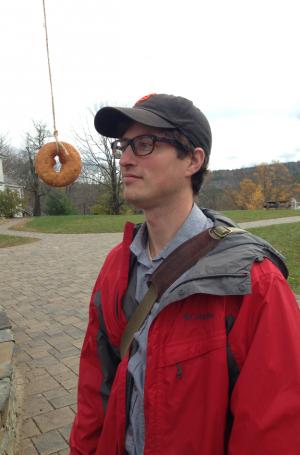 In August, Caleb Clark, faculty and chair of the MA in Teaching with Technology program, led an “E-Textiles” workshop for kids at the Bennington Free Library. An engaged group of 18 kids learned how to add blinking lights to anything they sew, using conductive thread, a battery holder, some small LED bulbs, and what Caleb referred to as a “twinkle chip.” “Believe it or not, this is engineering,” said Caleb, explaining that the workshop was intended to attract both girls and boys to the field. The program was made possible by funding from the Vermont Community Foundation Innovations and Collaborations grant: .
In August, Caleb Clark, faculty and chair of the MA in Teaching with Technology program, led an “E-Textiles” workshop for kids at the Bennington Free Library. An engaged group of 18 kids learned how to add blinking lights to anything they sew, using conductive thread, a battery holder, some small LED bulbs, and what Caleb referred to as a “twinkle chip.” “Believe it or not, this is engineering,” said Caleb, explaining that the workshop was intended to attract both girls and boys to the field. The program was made possible by funding from the Vermont Community Foundation Innovations and Collaborations grant: .
Last summer, math professor Matt Ollis worked with Gage Martin ’15 on several research projects supported by a faculty professional development grant and a Town Meeting scholarship. Their work resulted in a co-authored paper submitted to the Australasian Journal of Combinatorics, titled “R-sequencings and strong half-cycles from narcissistic terraces.” As you surely know already, R-sequencings and strong half-cycles are used to solve problems in several subfields of math such as graph embedding, graph decomposition, and design theory. The paper builds on work from an earlier paper co-authored by Matt and Devin Willmott ’11.
2014 Graduate Commencement
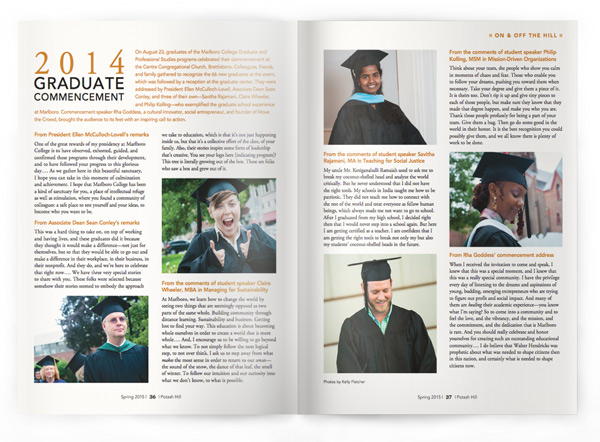
On August 23, graduates of the Marlboro College Graduate and Professional Studies programs celebrated their commencement at the Centre Congregational Church, Brattleboro. Colleagues, friends, and family gathered to recognize the 66 new graduates at the event, which was followed by a reception at the graduate center. They were addressed by President Ellen McCulloch-Lovell, Associate Dean Sean Conley, and three of their own—Savitha Rajamani, Claire Wheeler, and Philip Kolling—who exemplified the graduate school experience at Marlboro. Commencement speaker Rha Goddess, a cultural innovator, social entrepreneur, and founder of Move the Crowd, brought the audience to its feet with an inspiring call to action.
From President Ellen McCulloch-Lovell’s remarks
One of the great rewards of my presidency at Marlboro College is to have observed, exhorted, guided, and confirmed these programs through their development, and to have followed your progress to this glorious day…. As we gather here in this beautiful sanctuary, I hope you can take in this moment of culmination and achievement. I hope that Marlboro College has been a kind of sanctuary for you, a place of intellectual refuge as well as stimulation, where you found a community of colleagues: a safe place to test yourself and your ideas, to become who you want to be.
From Associate Dean Sean Conley’s remarks 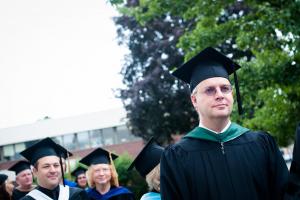 This was a hard thing to take on, on top of working and having lives, and these graduates did it because they thought it would make a difference—not just for themselves, but so that they would be able to go out and make a difference in their workplace, in their business, in their nonprofit. And they do, and we’re here to celebrate that right now…. We have three very special stories to share with you. These folks were selected because somehow their stories seemed to embody the approach we take to education, which is that it’s not just happening inside us, but that it’s a collective effort of the class, of your family. Also, their stories inspire some form of leadership that’s creative. You see your logo here [indicating program]? This tree is literally growing out of the box. These are folks who saw a box and grew out of it.
This was a hard thing to take on, on top of working and having lives, and these graduates did it because they thought it would make a difference—not just for themselves, but so that they would be able to go out and make a difference in their workplace, in their business, in their nonprofit. And they do, and we’re here to celebrate that right now…. We have three very special stories to share with you. These folks were selected because somehow their stories seemed to embody the approach we take to education, which is that it’s not just happening inside us, but that it’s a collective effort of the class, of your family. Also, their stories inspire some form of leadership that’s creative. You see your logo here [indicating program]? This tree is literally growing out of the box. These are folks who saw a box and grew out of it.
From the comments of student speaker Claire Wheeler, MBA in Managing for Sustainability At Marlboro, we learn how to change the world by seeing two things that are seemingly opposed as two parts of the same whole. Building community through distance learning. Sustainability and business. Getting lost to find your way. This education is about becoming whole ourselves in order to create a world that is more whole…. And, I encourage us to be willing to go beyond what we know. To not simply follow the next logical step, to not over think. I ask us to step away from what makes the most sense in order to return to our senses— the sound of the snow, the dance of that leaf, the smell of winter. To follow our intuition and our curiosity into what we don’t know, to what is possible.
At Marlboro, we learn how to change the world by seeing two things that are seemingly opposed as two parts of the same whole. Building community through distance learning. Sustainability and business. Getting lost to find your way. This education is about becoming whole ourselves in order to create a world that is more whole…. And, I encourage us to be willing to go beyond what we know. To not simply follow the next logical step, to not over think. I ask us to step away from what makes the most sense in order to return to our senses— the sound of the snow, the dance of that leaf, the smell of winter. To follow our intuition and our curiosity into what we don’t know, to what is possible.
From the comments of student speaker Savitha Rajamani, MA in Teaching for Social Justice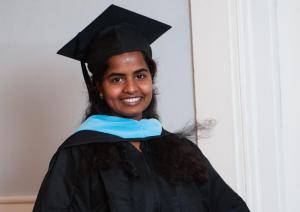 My uncle Mr. Kotiganahalli Ramaiah used to ask me to break my coconut-shelled head and analyze the world critically. But he never understood that I did not have the right tools. My schools in India taught me how to be patriotic. They did not teach me how to connect with the rest of the world and treat everyone as fellow human beings, which always made me not want to go to school. After I graduated from my high school, I decided right then that I would never step into a school again. But here I am getting certified as a teacher. I am confident that I am getting the right tools to break not only my but also my students’ coconut-shelled heads in the future.
My uncle Mr. Kotiganahalli Ramaiah used to ask me to break my coconut-shelled head and analyze the world critically. But he never understood that I did not have the right tools. My schools in India taught me how to be patriotic. They did not teach me how to connect with the rest of the world and treat everyone as fellow human beings, which always made me not want to go to school. After I graduated from my high school, I decided right then that I would never step into a school again. But here I am getting certified as a teacher. I am confident that I am getting the right tools to break not only my but also my students’ coconut-shelled heads in the future.
From the comments of student speaker Philip Kolling, MSM in Mission-Driven Organizations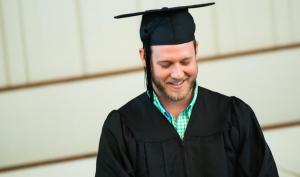 Think about your team, the people who show you calm in moments of chaos and fear. Those who enable you to follow your dreams, pushing you toward them when necessary. Take your degree and give them a piece of it. It is theirs too. Don’t rip it up and give tiny pieces to each of those people, but make sure they know that they made that degree happen, and make you who you are. Thank those people profusely for being a part of your team. Give them a hug. Then go do some good in the world in their honor. It is the best recognition you could possibly give them, and we all know there is plenty of work to be done.
Think about your team, the people who show you calm in moments of chaos and fear. Those who enable you to follow your dreams, pushing you toward them when necessary. Take your degree and give them a piece of it. It is theirs too. Don’t rip it up and give tiny pieces to each of those people, but make sure they know that they made that degree happen, and make you who you are. Thank those people profusely for being a part of your team. Give them a hug. Then go do some good in the world in their honor. It is the best recognition you could possibly give them, and we all know there is plenty of work to be done.
From Rha Goddess’ commencement address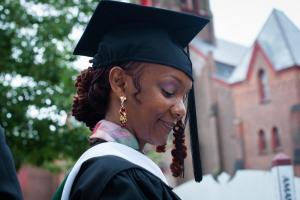 When I received the invitation to come and speak, I knew that this was a special moment, and I knew that this was a really special community. I have the privilege every day of listening to the dreams and aspirations of young, budding, emerging entrepreneurs who are trying to figure out profit and social impact. And many of them are healing their academic experience—you know what I’m saying? So to come into a community and to feel the love, and the vibrancy, and the mission, and the commitment, and the dedication that is Marlboro is rare. And you should really celebrate and honor yourselves for creating such an outstanding educational community…. I do believe that Walter Hendricks was prophetic about what was needed to shape citizens then in this nation, and certainly what is needed to shape citizens now.
When I received the invitation to come and speak, I knew that this was a special moment, and I knew that this was a really special community. I have the privilege every day of listening to the dreams and aspirations of young, budding, emerging entrepreneurs who are trying to figure out profit and social impact. And many of them are healing their academic experience—you know what I’m saying? So to come into a community and to feel the love, and the vibrancy, and the mission, and the commitment, and the dedication that is Marlboro is rare. And you should really celebrate and honor yourselves for creating such an outstanding educational community…. I do believe that Walter Hendricks was prophetic about what was needed to shape citizens then in this nation, and certainly what is needed to shape citizens now.
Alumni News

Curiosity’s Itch
For 26 years, David Holzapfel ’72 has employed the same model of experiential learning he engaged in at Marlboro College for fifth and sixth-graders at Marlboro Elementary School. In November, David was recognized by the Vermont Humanities Council with the 2014 Victor R. Swenson Humanities Educator Award.
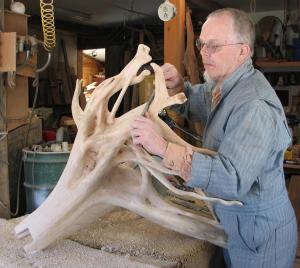 A sign at the front of David Holzapfel’s classroom quotes educator John Holt: “The true test of intelligence is not what we know how to do, but how we behave when we don’t know what to do.” David says it’s been there since he started teaching at Marlboro Elementary School in 1989, and in many ways it defines his unabashedly hands-on, inquiry-based approach to education.
A sign at the front of David Holzapfel’s classroom quotes educator John Holt: “The true test of intelligence is not what we know how to do, but how we behave when we don’t know what to do.” David says it’s been there since he started teaching at Marlboro Elementary School in 1989, and in many ways it defines his unabashedly hands-on, inquiry-based approach to education.
“Curiosity’s itch is satisfied through focused learning, through real experience,” says David, who compares his classroom investigations to his Plan of Concentration in Italian literature, poetry, and translation. “My own experiences of conducting independent research at Marlboro College serve as a model for the immersive education I engage in with students.”
David didn’t always know he would be a teacher. He devoted 16 years after college to woodworking, establishing a studio called Applewoods with his wife Michelle Chasse Holzapfel ’73, and creating other-worldly furniture from hardwood slabs and burls. He began teaching in 1979 as an artist-in-residence, first with the Horizons Program, followed by the Vermont Council on the Arts. Over the years he enjoyed woodworking, mask making, and totem pole carving with students.
“Those varied experiences enabled me to recognize how much I enjoyed ‘doing stuff’ with kids,” he says. “‘Doing stuff’ with kids has continued to be my favorite aspect of teaching.” Since he began teaching, his time in the studio has been limited; he works primarily on commissions at this point. “But whether in the studio or in the classroom with kids, the same essential issues of problem solving are at the forefront.”
Although David finds countless opportunities for “doing stuff” with kids in the classroom, it’s his forays into hands-on field research that he finds most satisfying. During his time at Marlboro Elementary School, he’s developed three extensive field research experiences with kids. He leads weeklong adventures to New York City and Cape Cod on alternate years, and natural history studies at Hogback Mountain Conservation Area every fall. In each case, students conduct individual research projects, such as interviewing traders at the New York Stock Exchange, learning the history of lighthouses from local experts, and collecting data on Vermont’s changing forest ecosystems.
“In addition to deep, active learning, field research instills in students a sense of place,” says David. “Meaningful interactions with a location and work within a community engender in all of us a sense of belonging, of connection.” It also takes an extraordinary amount of time, and planning, and support, and trust, things often discouraged by ever-growing pressures toward more superficial “coverage” and preparation for standardized tests. David credits former principals Bruce Cole ’59 and Connie Barton with establishing a tone at Marlboro School that continues to this day: teachers are encouraged to teach what they’re excited about.
“The temporal aspects of learning seem rarely considered by policy makers, and yet we all know that those topics to which we dedicate time are the topics we truly know; this is immersive learning. Field research is hard work for educators in the current climate. But I believe that for students and teachers alike, nothing builds a positive sense of purpose and confidence better than the accomplishment of a difficult task done well.”
David and Michelle presented a show titled “True to Form” at Drury Gallery from January 20 through February 13. For more about their work go to: holzapfelwoodworking.com.
Class Notes
Class notes are listed by year and include both graduates and nongraduates; the latter are listed under the class with which they are associated.
’51
“Joan and I just completed a fascinating 18-day tour in Spain, Portugal, and Madeira,” writes CHARLES STAPLES. “Saw much of historical and scenic interest. Still maintaining good health and strength at 85.”
’52
R. BOYD THOMPSON moved to Belfast, Maine, in November. “New address is Crosby Manor Condo Living. Very exciting.”
’57
REGINALD RODMAN published a new book with Xlibris titled Nicodemus: The Life and the Legend (ISBN 9781499045659), about the biblical character who meets with Jesus and experiences a spiritual awakening.
’65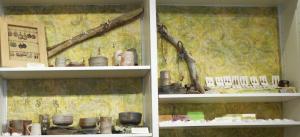 “My new novel, We Will What We Will, is available on Kindle, and will be available on Amazon,” writes JONATHAN POTTER. He is now an adjunct faculty at University of Maine, Rockland, and will be directing Goldoni’s Servant of Two Masters at this year’s Midcoast Actor’s Studio.
“My new novel, We Will What We Will, is available on Kindle, and will be available on Amazon,” writes JONATHAN POTTER. He is now an adjunct faculty at University of Maine, Rockland, and will be directing Goldoni’s Servant of Two Masters at this year’s Midcoast Actor’s Studio.
’66
“Finishing 34 years as land conservation manager at Trustees of Reservations in Massachusetts,” says WESLEY WARD. “Consulting with Solid Ground Consulting, based in Portland, Oregon, with a national practice.”
’67
“If anyone still remembers the DAVID DORMAN who left Marlboro in 1976 but only received a degree in 1979, and has lived in obscurity ever since, you may be interested in this septuagenarian’s update,” writes David. “Last year I took five and a half weeks out of my retirement project— a story for another time—to walk the Camino from St. Jean Pied-de-Port to Finistera across Northern Spain. This year I took a year out of my now almost moribund retirement project to work at Kwara State University in Malete, Nigeria. I will be returning to Chicago in February, from where I hope to resurrect my retirement project. Be well.”
’68
“I am in the process of planning to walk from New England to Koinonia Farm in Americus, Georgia,” writes SHEILA GARRETT. “Hope to start in August 2015 and arrive in time for the School of the Americas Watch gathering at Forth Benning in November. If you might be along the route, starting in Connecticut, and would be willing to offer a bed or couch, please let me know. This is a trip I’ve been dreaming of doing for several years, especially since 2011, when I travelled there by bus and train. I will be walking on secondary roads, not the AT, and visiting with Quakers, Buddhists, and others along the way.
’71
“Loving the rhythm of the ravens,” writes DEBORAH TUTTLE MARTINEZ. “Saw a western jay and a yellow finch at Griffith Observatory the other day.”
’72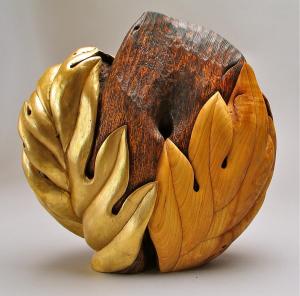 “My big news is that in February 2015, I turn 65 years old,” writes GAIL HENRY. “Hello Medicare and pension. At Marlboro I don’t think any of us thought 65 was attainable, or desirable, but it looks a lot better now. I’m still in touch with many of my friends from the college and grateful for every one of them. Amazingly, I don’t think I’m having a party for my birthday, even though it’s a Saturday. I’d like to be in the South Pacific but doubt that will happen.”
“My big news is that in February 2015, I turn 65 years old,” writes GAIL HENRY. “Hello Medicare and pension. At Marlboro I don’t think any of us thought 65 was attainable, or desirable, but it looks a lot better now. I’m still in touch with many of my friends from the college and grateful for every one of them. Amazingly, I don’t think I’m having a party for my birthday, even though it’s a Saturday. I’d like to be in the South Pacific but doubt that will happen.”
’73
DANIEL HUDKINS writes, “This summer, I checked one more item off the bucket list as I rode a 1983 Yamaha Vision from Maine to California, going north of Lake Superior and the Lake of the Woods. North coast of Lake Superior was spectacular. Some camping, some motels, some staying with friends, including a couple of days with JOHN WOODLAND and his wife in Superior, Montana. I have now been in all 50 states and all 10 Canadian provinces. I just returned from a week in Songdo, South Korea, visiting my younger daughter, who is teaching at an American international school there. If anyone needs a post-partum doula, my older daughter, Katherin, has launched a business called Seedlings for those in the greater Boston area. Life in San Jose continues fine, and we would love to see anyone who’s passing through.”
’78
CHRIS NOTH may be the only alumnus whose name has been used as a clue on Says You!, the public radio game show of bluff and bluster, words and whimsy. In a question about the names of TV shows, in which they listed actors from minor to major until someone guessed the show, Chris was the name that gave away the show The Good Wife.
NAT SIMKINS writes, “Participated in the Crane Estate Show and Sale exhibit at the Crane Castle in Ipswich, Massachusetts, and recently sold a painting via the internet: NatSimkins.com. Still working full time as an application support analyst for Universal Wilde. My wife of 34 years continues to run the Natick Community Organic Farm. Life is going well, and I have connected with some Marlboro alumni on Facebook—feel free to look me up. The lessons I learned at Marlboro about critical thinking, expository writing, Western philosophy, literature, and art have served me well and allowed me to adapt to a changing world. Nothing like a good liberal arts education to prepare for the future. Thanks, Marlboro.”
Documenting history: Jack Rossiter-Munley ’12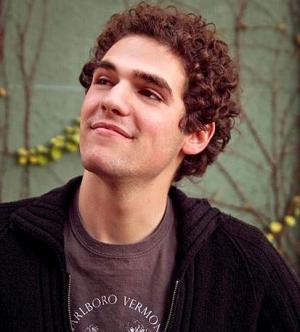 “I first learned about Federal Judge Damon J. Keith when I was at Marlboro during a tutorial with Kate Ratcliff on politics and music in the United States,” says Jack Rossiter-Munley. Little did he know then that fellow alumnus Jesse Nesser ’13 would approach him to help produce a film about the legendary judge, now 92 years old and serving on the U.S. Sixth Circuit Court of Appeals. The upcoming film, Walk With Me, relates the legacy of the civil rights movement as told through the life of Judge Keith and his landmark decisions on issues ranging from school discrimination to the right to privacy.
“I first learned about Federal Judge Damon J. Keith when I was at Marlboro during a tutorial with Kate Ratcliff on politics and music in the United States,” says Jack Rossiter-Munley. Little did he know then that fellow alumnus Jesse Nesser ’13 would approach him to help produce a film about the legendary judge, now 92 years old and serving on the U.S. Sixth Circuit Court of Appeals. The upcoming film, Walk With Me, relates the legacy of the civil rights movement as told through the life of Judge Keith and his landmark decisions on issues ranging from school discrimination to the right to privacy.
“Judge Keith has spoken at length during our filming about his views, not only on the history he witnessed and shaped but also on more current events, always with a sense of positivity,” says Jack. “The knowledge that during his more than 60-year fight for equality, a fight that is far from over, Judge Keith never became cynical or disheartened, never let his hope desert him, has been deeply affecting. I hope to emulate his kindness and integrity as best I can in my own life, and I am passionately committed to bringing his story to a wider audience.”
Jack couldn’t do that alone, and for him one of the most rewarding parts of filmmaking has been collaborating with committed, creative individuals, many of them from Marlboro. In addition to fellow producer and director Jesse Nesser, help has come from co-producer Patrick Lane FS13, music producer Rebecca Gildea ’12, and music professor Matan Rubinstein, who created the score. “Marlboro challenges students to conduct complex, independent, intellectual work, not unlike the process of making a historical documentary,” says Jack. “The passion required to complete such work is undoubtedly present in all the Marlboro alumni working on this project.” Learn more at thedkdoc.com and facebook.com/thedkdoc.
’80
“Yo ho, y’all,” writes LORI KIRSTEIN. “I’ve returned home from 13 years in the Bay Area, to my native Cincinnati. Currently in a little process called redefining my life at the tender age of whatever-the-heck-age-I-am-now. I’m a SAG-AFTRA actor, a professional singer/ songwriter, and a designer of furniture art. Doing freelance work as an associate producer at Possible, a digital marketing firm in Cincinnati, and working on getting myself hired. Had a partner for 12 years, who passed on in 2013. Was rescued from being the total wandering Jew by a friend I’ve known since we were 6, so we’re doing Three’s Company with two guys and a girl. If you’re in Cincinatti, look me up. Hit me up on Facebook too, and you can find me also at Whimsical Art—Lori Kirstein Designs. Love to all.”
’81
“Still painting, dancing, and I’ve started playing the flute again,” says TRICIA LOWREY Lippert. “Paid my house off this summer. Life is good.”
’82
BRAD OLDENBURG’S documentary Aulis Sallinen: Music, Man & Nature was aired on PBS in northeast Pennsylvania in December. “The documentary has been aired in many other countries, but this will be the first time in America,” writes Brad. “As to my cello fingers flying up and down the fingerboard, well, they are rusty. But I am looking forward to playing with a local college-community orchestra in the spring semester—Dvorak’s New World Symphony. My skills in carpentry and construction are keeping me solvent. Best regards to Marlboro. Hope to travel there this summer for the Marlboro Music Festival.”
“After many years, I am now counting the months (10) until (god willing) I received my MJEd and my ordination as a cantor,” writes KATE JUDD MJEd. “I continue to have the honor to serve as spiritual leader of the Brattleboro area Jewish community. I see ELYSSE LINK FS81 regularly, and we reminisce about Marlboro.
’83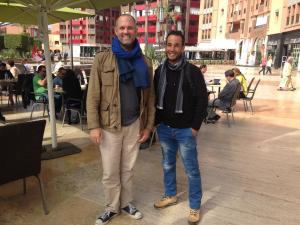 REGINA GRABROVAC is Washington County food system coordinator for Healthy Acadia and Washington County: One Community. “Keeps me well engaged,” she writes.
REGINA GRABROVAC is Washington County food system coordinator for Healthy Acadia and Washington County: One Community. “Keeps me well engaged,” she writes.
’84
“My most interesting recent news is actually still ahead of me,” writes KATHRYN MALENEY. “This fall I applied and just two weeks ago I learned that I’ve been accepted to the Living School for Action and Contemplation in Albuquerque, New Mexico. The program commences in September 2015. Like Marlboro it’s a small program, but unlike Marlboro it’s under the auspices of a Franciscan monastery founded by Richard Rohr. The program works mostly through distance learning, and where it will lead I’m uncertain. But perhaps two years from now I’ll have some real news for you.”
’86
ANDERS NEWCOMER is busy teaching English at Greater New Bedford Vocational Technical High School, and busy with his family, reports mother Grace Gibson Newcomer. “KIRSTEN NEWCOMER ’82 is doing well in a software firm—and is a trustee of Marlboro,” she adds.
’87
JENNIFER WEST moved to Steamboat Springs, Colorado. You can visit her newly opened Etsy shop, Off the Grid Designs, with “wild adornments for carbon-based life-forms."
’89
“I currently work as the database manager, meaning I run the online catalog, at the Peninsula Library System in San Mateo, California,” writes JOHN BOGGS. “I live in Oakland with my wife, an elementary teacher, and our dog, a Cavalier mix. Off work, I’m learning to build wooden boats at the Arques School in Sausalito.”
’90
“Vermont is a great laboratory,” said SARA COFFEY in a profile in the Autumn 2014 issue of Vermont Life magazine, which described the founding and development of her Guilford-based Vermont Performance Lab. “Living and working in a small community is a great strength and asset for this kind of work. I can have access to people, and there is also a great willingness to collaborate, share expertise, be curious, and welcome artists.”
’93 “We need to be smarter about our approach to crime. We need to be looking at public health and acknowledge that drug addiction is a public health problem that shows up in criminal behaviors,” says SCOTT WILLIAMS. A lawyer in Barre, Vermont, Scot was elected state’s attorney for Washington County in November, unseating seven-year veteran Tom Kelly.
“We need to be smarter about our approach to crime. We need to be looking at public health and acknowledge that drug addiction is a public health problem that shows up in criminal behaviors,” says SCOTT WILLIAMS. A lawyer in Barre, Vermont, Scot was elected state’s attorney for Washington County in November, unseating seven-year veteran Tom Kelly.
’94
“I have worked for the Bridges to Health program for nearly five years now, and I honestly believe it to be one of the most positive social service programs out there,” writes STEFANIE CRENSHAW. “It is being piloted only in New York State at this time, but it will hopefully branch out to other states soon.” Stephanie was recognized as Employee of the Year by Astor Services for Children and Families and the New York State Coalition for Children’s Mental Health. “Marlboro will always be a second home to me. The magic of those four years will never be forgotten, and I know there are so many of us out there who feel the same way.”
’95
“Lots of transition,” writes JODI CLARK. “Jenny Karstad ’97 and I bought our first home in West Brattleboro over the summer. We have a spare room and love visitors (hint, hint). I am both thrilled and sad to have come to more transitions in my time with Marlboro. Firstly, I have joined a very elite club of double alumni: I completed my second master’s degree at the graduate school, with a Capstone Project on learning collaboratives, and can now put MSM after my name. I am also immensely grateful and humbled by my three and a half years working in student life again, but it is that same passion for community engagement that has called me out beyond Potash Hill.” Jodi is a project manager for Southeastern Vermont Economic Development Strategies, and training as a leadership guide with the Generative Council at the Center for Nature and Leadership.
“I started my new career in solar on December 1, at RGS Energy in western Massachusetts,” writes BRAD CAMODY. “Woot!”
’96
“Hello from Hollywood,” writes ERIN PETERS. “I just started as assistant editor on TNT’s The Last Ship (that’s picture editing, not writing). After all my liberal arts education, I make a living editing explosions and shoot-outs and it’s fun. Cheers, cheers!”
’97
SAMONIA MEREDITH BYFORD writes, “My husband Dennis and I welcomed our children into the world two months early. Meredith and Andrew are home and doing well.”
’98
“After five and a half years in Paris, including two years in the master’s program of arts de la scène at Université de Paris and a year at École Internationale de Theatre Jacques Lecoq, I moved back to L.A. to remember why I can’t stand L.A.,” writes AARON KAHN. He is now in Hong Kong, teaching there and working with the more than 200 teachers of Pure Yoga in the region. He is still planning to make more theater and sing more sacred harp (he sang at conventions in both the U.K. and Poland this fall). “If you are in Hong Kong, please say ‘Hello.’ I always feel nostalgic for Vermont and Marlboro. Travel is great. So are roots.”
’99
“I am a cheese maker,” writes JENNIFER DOWNEY. “Of course, an artist as well. I own and operate a 20-acre farm, Grade A dairy, and cheese room in Brookneal, south central Virginia, where I milk dairy goats and Jersey cows and create a glorious market garden each season. My children have all grown up, as they do, so it’s just me on the farm. I hope to be producing aged raw milk cheeses in 2015.”
Cutting-Edge Manufacturing: Joshua McAloon ’14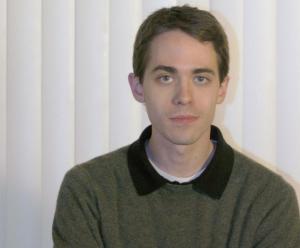 Although Josh McAloon’s Plan was in photography and cultural history, he also had an interest in all things technical. It’s therefore no coincidence that he landed a job in the exciting world of “laser sintering” for the biomedical and aerospace manufacturing industries, working at Oxford Performance Materials (OPM), in New Britain, Connecticut.
Although Josh McAloon’s Plan was in photography and cultural history, he also had an interest in all things technical. It’s therefore no coincidence that he landed a job in the exciting world of “laser sintering” for the biomedical and aerospace manufacturing industries, working at Oxford Performance Materials (OPM), in New Britain, Connecticut.
“Laser sintering refers to the way in which these machines perform the ‘additive manufacturing process,’ building a part layer by layer from a three-dimensional blueprint,” says Josh. “Individual layers of powdered polymer are laid down, one atop the other, while two overhead lasers score patterns into the powdered layers, melting and fusing (sintering) the material to itself.”
While laser sintering is not something you come across every day on Potash Hill, Josh found that many skills he gained at Marlboro have helped him considerably in his position.
“Critical thinking is important, as additive manufacturing is a relatively young industry, and as such there are unexpected and unproven situations that tend to arise,” says Josh. “To navigate these situations, employees not only need to be able to work together, but need to be able to keep focused on new strategies for success.”
Josh is excited to be working in OPM’s biomedical facility, where they manufacture cranial and facial parts to precise, patient-specific parameters. “Most of the patients who benefit from these medical implants are trauma victims and cancer patients who have lost portions of their skull or had them removed surgically,” says Josh. “There is something different about knowing that when a part leaves the building it’s actually going to become part of somebody.”
’00
ALLYSON FAUVER writes, “I’m currently serving on the board of directors for Camp Pemigewassett, a summer camp for boys in New Hampshire. Pemi is looking for a head chef for summer 2015, and I instantly thought of Marlboro’s approach to food and kitchen as an example we would be interested in seeing there.”
’01
“I welcome my second son this year: Desmond Coello,” writes CARRIE STERR COELLO. “My son Armando Coello is 2. I am teaching natural childbirth classes. My husband Ben Coello and I are enjoying the Seattle area.”
’02
In October, TIM COLLINS performed “The Script,” his one-man show about sexual assault prevention, rape culture, and masculinity, for army, navy, and air force personnel at the Presidio Military Base in Monterey, California.
’03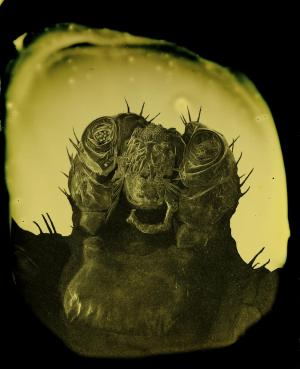 ESTHER WAKEFIELD is teaching English in South Korea, report her parents. “This is her fourth and final year, and she plans on going to graduate school in occupational therapy when she returns in August 2015.”
ESTHER WAKEFIELD is teaching English in South Korea, report her parents. “This is her fourth and final year, and she plans on going to graduate school in occupational therapy when she returns in August 2015.”
’04
HEATHER BRYCE received a Vermont Arts Council grant to support the creation of “Breathing Under Water,” an interdisciplinary, site-specific work that will be created in collaboration with community members from Montpelier and Middlesex, Vermont. JIM LOWE ’73 called it a “beautiful and abstract exercise in movement,” in a Rutland Herald review of a Bryce Dance Company performance last September.
’05
“I’m in Santa Fe, New Mexico, getting my master’s degree in Eastern classics at St. John’s College,” writes MICHELLE WRUCK. “Chinese, Japanese, and Indian philosophy, history, language, literature, and poetry. Good stuff.”
’06
“I’m currently working at the University of Vermont, for academic support programs, coordinating peer tutoring in academic skills,” writes MINNA ROUSSI. “I moved back to Vermont just last year, and have been out of the Marlboro loop. Thanks for sending along the article that Kate participated in. I’m in the alumni facebook group and love hearing news.”
’07
LAURA BAETSCHER is a graduate student at UCLA’s Fielding School of Public Health. She has conducted her field research for her MPH degree in the rural western highlands of Guatemala, where health services are thinly spread. “It was exciting to reduce maternal and infant deaths in rural areas through community engagement,” says Laura, who worked with an organization called Nutri-salud.
“I’ve arrived at something of a career after many years, working on mobile health (mHealth) projects at Dimagi,” writes MATT LEVASSEUR. “We make apps for frontline health workers to use as job aids and for data collection. We’ve been working on a project in Haiti with Pathfinder International (big NGO) that’s been amazing."
’09
TALIA JACKSON is working as a therapist at a community mental health agency.
’10
As of this past January, SARAH HOROWITZ has been working as a curatorial assistant at the Picker Art Gallery and Longyear Museum of Anthropology at Colgate University in Hamilton, New York. She is conducting provenance research on objects in the collections, contributing to gallery publications, as well as curating an exhibition featuring the work of contemporary multimedia artist, Jaye Rhee, scheduled to open in the Fall of 2015.
KENTON CARD is working with the Planning and Conservation League, an environmental advocacy/lobbying organization in Sacramento, California. “Please let career services know that we’re always interested in bright interns,” writes Kenton. “As I’m very new there, I can’t say they’ll be paid—which has its own problems, no doubt. But, I can certainly introduce any bright students to the executive director and get them involved in some real environmental or housing advocacy in the capital of California.”
’11DEVIN WILLMOTT is in the graduate program for mathematics at the University of Kentucky. He continues to collaborate with mathematics professor Matt Ollis, in work that stems from the research in combinatorics they initiated while he was a student. Their fourth co-authored paper, titled “Constructions for terraces and R-sequencings, including a proof that Bailey’s Conjecture holds for abelian groups,” was published this year in the Journal of Combinatorial Designs (Vol. 23, pp. 1-17).
SARI BROWN writes, “Since graduating from Marlboro I entered Candler School of Theology at Emory University, as a Woodruff Scholar, and I completed my Master of Divinity this December. I focused on Christian ethics, conflict transformation, and ecological theology. I am now living in Bogotá, Colombia, and engaged to a social worker and pastor from here. I hope to work to build spiritual community around sustainable development and to work with issues of peace, healing, and resistance in the midst of the ongoing civil war.”
’12
ERIC JOYCE, JON NOTWICK, and NICK ROUKE had a group show of their photography at Grumpy’s Café, in Chelsea, New York. “Since attending Marlboro College, where we studied photography together, we have moved in different directions, both in our artwork and our lives,” they say. Nick is in Pelham, New York, while Eric and Jon live and work in Brattleboro, Vermont. “When putting this show together we wanted to look at how our independently meandering paths can come together.”
“I saw a lot of really, really smart people on my college campus who were otherwise disengaged from what was happening overseas,” said BRANDON WILLITTS in a PBS story last November. “It wasn’t because they weren’t interested. It was because we just didn’t know how to meet them halfway on some of this stuff.” Brandon was interviewed as part of a story about Words After War, a literary nonprofit he founded to bring civilians and veterans together for writing workshops.
“Hio Ridge Dance spent summer 2014 devising a new dance piece about our home base of Denmark, Maine.” writes COOKIE HARRIST. “Placeholders.” which they toured around the northeast in the fall, is an hour-long duet performed by Cookie and collaborator Delaney McDonough, featuring projections of short films made with local kids in local scenery. “And check out ‘Placeholders’ (the movie). We combined three smaller video sections of the piece into one film. We couldn’t resist celebrating these wonderful kids that we aren’t allowed to kidnap and take on the road."
GRACE LEATHRUM is working as a special events coordinator at The Mount, Edith Wharton’s Home in Lenox, Massachusetts. “I stay busy coordinating 15 weddings a year, and planning other events like our recent Halloween Masquerade and an upcoming Farm to Table Dinner. Being a longtime Edith Wharton fan I feel at home here, and it’s a really fascinating and rewarding process working with a couple from their first visit to the venue to their walk down the aisle. Looking to get married in 2016? Check out my blog or email me at gleathrum@edithwharton.org.
ANNE SAUNDERS is now in Benin, West Africa, serving in the Peace Corps, reports her grandmother Rosemary Myers.
’13MADDIE HOLM and DIRK STAMM report that on September 26 they got married at city hall in Portland.
“Hey Marlboro, are you worried about finding work when you graduate?” writes CAITLYN CHARLES. “Did you know that any American under the age of 31 who does not have tuberculosis can be granted a one-year work and holiday visa to work and travel in Australia? I have been in Oz for almost a year now, and it turns out that there are heaps of work here, and their minimum wage is about $17/hour. I definitely recommend the working holiday to new alumni who are not sure what they want to do after graduation. I still think of Marlboro often and tell stories of my time there.”
“The two most recent features I have worked on as art director have begun their festival circuits,” writes JOSHUA “PETEY” PETERSEN. “The Mend, by director John Magary and starring Josh Lucas, premiered at South by Southwest in the narrative competition in 2014, and was most recently being screened at MoMA for the exhibit “Best Film Not Playing in a Theater Near You.” Advantageous, by director Jennifer Phang and starring Jacqueline Kim and Jennifer Ehle, premieres at the end of January 2015 in this year’s Sundance Film Festival.”
’14
ELISABETH JOFFE writes, “I work in the membership department at Solar Energy Industries Association (alright, relevant to my environmental studies degree), a lobbying group in D.C. I also do photography on the side for individuals, couples, and families in the Baltimore and D.C. area.”
Graduate and Professional Studies
MBA
JULIE FAHNESTOCK MBA ’14 has been making regular blog entries on justmeans.com, a leading site for sustainability news, including a recent one on MBA alumnus John Tedesco and Green Mountain Power (GMP) (see profile in this issue). “This is an earth-shattering, groundbreaking accomplishment for both GMP and for the B Corp movement,” Julie writes. “It means that a utility company is creating power while generating positive impact, a capability not typically associated with traditional fossil-fuel utilities. That’s because GMP is far from traditional."
MDO
Three alumni were recognized as “Rising Stars” by Vermont Business Magazine in September: HILLARY BOONE MSM-MDO ’14, who is now the program director for Benchmarks for a Better Vermont; RICHARD BERKFIELD, Certificate in Nonprofit Management ’11, who works at Food Connects in Putney; and ELA CHAPIN, Certificate in Nonprofit Management ’12, who is on the Vermont Housing and Conservation Board in Montpelier. “For these young professionals it’s not just about business,” says Vermont Business Magazine publisher John Boutin. “It’s about them making a difference in their communities.”
Former Faculty and Staff
“I think the system is rotten to the core. We have to change it,” says retired sociology professor JERRY LEVY, who ran for state senate on the Liberty Union Party ticket in November. Jerry believes the state senate race is usually between “pragmatists,” and does not place himself in that category—and he is not an advocate for compromise and “incremental progress.” Jerry also celebrated 10 years of performing Marx in Soho, and premiered his original play The Third Coming: Marx Returns in November.
SHERRY BROMLEY, registrar from 1963 to 1993, says “I am comfortably settled in Putney, but miss my old Marlboro haunts of 37 years.”
Book Shelf
 “You are afraid of the water—have been ever since you were eight and got knocked unconscious in the breakers, hitting your head on the bottom and waking up below with a vision of the world being ripped apart and scattered by the currents you viewed it through. Salt in your nose and your lungs. Your father fished you out and said the whole thing only lasted a moment, but you’ve always remembered it being so much longer—a dark stretch of time that did not need to fit into other time because it could seep around the edges or sink into the pores.” — Emily Kiernan, Great Divide
“You are afraid of the water—have been ever since you were eight and got knocked unconscious in the breakers, hitting your head on the bottom and waking up below with a vision of the world being ripped apart and scattered by the currents you viewed it through. Salt in your nose and your lungs. Your father fished you out and said the whole thing only lasted a moment, but you’ve always remembered it being so much longer—a dark stretch of time that did not need to fit into other time because it could seep around the edges or sink into the pores.” — Emily Kiernan, Great Divide
Great Divide (Unsolicited Press, ISBN 978- 0615993164), a novel by Emily Kiernan ’09, follows a young woman fleeing from years of abuse in her Oregon seacoast home to an uncertain freedom with her boyfriend in the landlocked new world of the Kansas plains. The book is about memory, the power of the past to shape and subsume the present, and the pressing, terrible need to escape the drowning force of history.
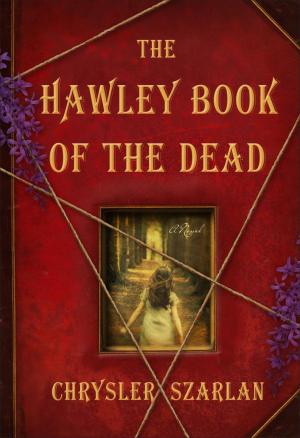 The Hawley Book of the Dead (Ballantine Books, ISBN 978-0345545022), a debut novel by Chrysler Szarlan ’83, was named a National Public Radio Best Book of 2014. In this suspenseful tale of magic and mysterious pasts, tragedy forces a worldfamous magician to flee Las Vegas with her three daughters to the only place she’s ever felt safe: the forest of Hawley Five Corners, in Massachusetts. Once there, she discovers the ancient book that may hold the key to her family’s shimmering history...and ultimately, to her own future.
The Hawley Book of the Dead (Ballantine Books, ISBN 978-0345545022), a debut novel by Chrysler Szarlan ’83, was named a National Public Radio Best Book of 2014. In this suspenseful tale of magic and mysterious pasts, tragedy forces a worldfamous magician to flee Las Vegas with her three daughters to the only place she’s ever felt safe: the forest of Hawley Five Corners, in Massachusetts. Once there, she discovers the ancient book that may hold the key to her family’s shimmering history...and ultimately, to her own future.
 Empty Hands, Open Arms: The Race to Save Bonobos in the Congo and Make Conservation Go Viral (Milkweed Editions, ISBN 978-1571313409) is the latest book from Deni Béchard ’97 (Potash Hill, Winter 2013). Based on Deni’s extensive travels in the Congo and Rwanda, this book explores the Bonobo Conservation Initiative’s (BCI) efforts to save the last living bonobos, which along with chimpanzees are our closest relatives. Working closely with Congolese communities, and addressing the underlying problems of poverty and unemployment in this war-torn region, BCI’s successes offer a powerful, truly postcolonial model of conservation.
Empty Hands, Open Arms: The Race to Save Bonobos in the Congo and Make Conservation Go Viral (Milkweed Editions, ISBN 978-1571313409) is the latest book from Deni Béchard ’97 (Potash Hill, Winter 2013). Based on Deni’s extensive travels in the Congo and Rwanda, this book explores the Bonobo Conservation Initiative’s (BCI) efforts to save the last living bonobos, which along with chimpanzees are our closest relatives. Working closely with Congolese communities, and addressing the underlying problems of poverty and unemployment in this war-torn region, BCI’s successes offer a powerful, truly postcolonial model of conservation.
 The Shirtmaking Workbook: Pattern, Design, and Construction Resources for Shirtmaking (Creative Publishing International, ISBN 978-1589238268) is the latest how-to compilation by David Coffin ’70. The sequel to Shirtmaking: Developing Skills for Fine Sewing (Taunton Press, 1998), this authoritative guide offers discriminating shirtmakers an amazing collection of custom detail patterns and ideas for men’s and women’s shirt styles. Whether you want a couture creation or a workshop coverall, this book provides the resources to help make your custom shirtmaking easier and more masterful.
The Shirtmaking Workbook: Pattern, Design, and Construction Resources for Shirtmaking (Creative Publishing International, ISBN 978-1589238268) is the latest how-to compilation by David Coffin ’70. The sequel to Shirtmaking: Developing Skills for Fine Sewing (Taunton Press, 1998), this authoritative guide offers discriminating shirtmakers an amazing collection of custom detail patterns and ideas for men’s and women’s shirt styles. Whether you want a couture creation or a workshop coverall, this book provides the resources to help make your custom shirtmaking easier and more masterful.
In Memoriam
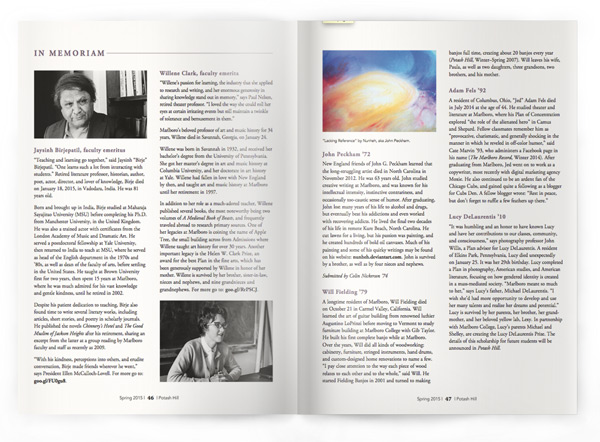
Jaysinh Birjepatil, faculty emeritus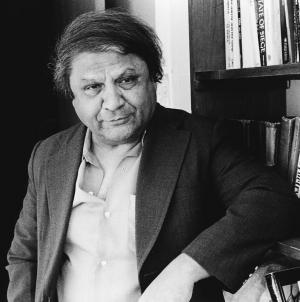 “Teaching and learning go together,” said Jaysinh “Birje” Birjepatil. “One learns such a lot from interacting with students.” Retired literature professor, historian, author, poet, actor, director, and lover of knowledge, Birje died on January 18, 2015, in Vadodara, India. He was 81 years old.
“Teaching and learning go together,” said Jaysinh “Birje” Birjepatil. “One learns such a lot from interacting with students.” Retired literature professor, historian, author, poet, actor, director, and lover of knowledge, Birje died on January 18, 2015, in Vadodara, India. He was 81 years old.
Born and brought up in India, Birje studied at Maharaja Sayajirao University (MSU) before completing his Ph.D. from Manchester University, in the United Kingdom. He was also a trained actor with certificates from the London Academy of Music and Dramatic Art. He served a postdoctoral fellowship at Yale University, then returned to India to teach at MSU, where he served as head of the English department in the 1970s and ’80s, as well as dean of the faculty of arts, before settling in the United States. He taught at Brown University first for two years, then spent 15 years at Marlboro, where he was much admired for his vast knowledge and gentle kindness, until he retired in 2002.
Despite his patient dedication to teaching, Birje also found time to write several literary works, including articles, short stories, and poetry in scholarly journals. He published the novels Chinnery’s Hotel and The Good Muslim of Jackson Heights after his retirement, sharing an excerpt from the latter at a group reading by Marlboro faculty and staff as recently as 2009.
“With his kindness, perceptions into others, and erudite conversation, Birje made friends wherever he went,” says President Ellen McCulloch-Lovell. Read more.
Willene Clark, faculty emerita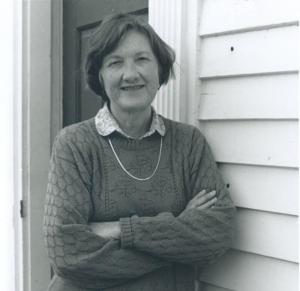 “Willene’s passion for learning, the industry that she applied to research and writing, and her enormous generosity in sharing knowledge stand out in memory,” says Paul Nelsen, retired theater professor. “I loved the way she could roll her eyes at certain irritating events but still maintain a twinkle of tolerance and bemusement in them.”
“Willene’s passion for learning, the industry that she applied to research and writing, and her enormous generosity in sharing knowledge stand out in memory,” says Paul Nelsen, retired theater professor. “I loved the way she could roll her eyes at certain irritating events but still maintain a twinkle of tolerance and bemusement in them.”
Marlboro’s beloved professor of art and music history for 34 years, Willene died in Savannah, Georgia, on January 24.
Willene was born in Savannah in 1932, and received her bachelor’s degree from the University of Pennsylvania. She got her master’s degree in art and music history at Columbia University, and her doctorate in art history at Yale. Willene had fallen in love with New England by then, and taught art and music history at Marlboro until her retirement in 1997.
In addition to her role as a much-adored teacher, Willene published several books, the most noteworthy being two volumes of A Medieval Book of Beasts, and frequently traveled abroad to research primary sources. One of her legacies at Marlboro is coining the name of Apple Tree, the small building across from Admissions where Willene taught art history for over 30 years. Another important legacy is the Helen W. Clark Prize, an award for the best Plan in the fine arts, which has been generously supported by Willene in honor of her mother. Willene is survived by her brother, sister-in-law, nieces and nephews, and nine grandnieces and grandnephews. Read more.
 John Peckham ’72
John Peckham ’72
New England friends of John G. Peckham learned that the long-struggling artist died in North Carolina in November 2012. He was 63 years old. John studied creative writing at Marlboro, and was known for his intellectual intensity, instinctive contrariness, and occasionally too-caustic sense of humor. After graduating, John lost many years of his life to alcohol and drugs, but eventually beat his addictions and even worked with recovering addicts. He lived the final two decades of his life in remote Kure Beach, North Carolina. He cut lawns for a living, but his passion was painting, and he created hundreds of bold oil canvases. Much of his painting and some of his quirky writings may be found on his website: nunheh.deviantart.com. John is survived by a brother, as well as by four nieces and nephews.
Submitted by Colin Nickerson ’74
Will Fielding ’79
A longtime resident of Marlboro, Will Fielding died on October 21 in Carmel Valley, California. Will learned the art of guitar building from renowned luthier Augustino LoPrinzi before moving to Vermont to study furniture building at Marlboro College with Gib Taylor. He built his first complete banjo while at Marlboro. Over the years, Will did all kinds of woodworking: cabinetry, furniture, stringed instruments, hand drums, and custom-designed home renovations to name a few. “I pay close attention to the way each piece of wood relates to each other and to the whole,” said Will. He started Fielding Banjos in 2001 and turned to making banjos full time, creating about 20 banjos every year (Potash Hill, Winter–Spring 2007). Will leaves his wife, Paula, as well as two daughters, three grandsons, two brothers, and his mother.
Adam Fels ’92
A resident of Columbus, Ohio, “Jed” Adam Fels died in July 2014 at the age of 44. He studied theater and literature at Marlboro, where his Plan of Concentration explored “the role of the alienated hero” in Camus and Shepard. Fellow classmates remember him as “provocative, charismatic, and generally shocking in the manner in which he reveled in off-color humor,” said Cate Marvin ’93, who administers a Facebook page in his name (The Marlboro Record, Winter 2014). After graduating from Marlboro, Jed went on to work as a copywriter, most recently with digital marketing agency Moxie. He also continued to be an ardent fan of the Chicago Cubs, and gained quite a following as a blogger for Cubs Den. A fellow blogger wrote: “Rest in peace, but don’t forget to ruffle a few feathers up there.”
Lucy DeLaurentis ’10
“It was humbling and an honor to have known Lucy and have her contributions to our classes, community, and consciousness,” says photography professor John Willis, a Plan advisor for Lucy DeLaurentis. A resident of Elkins Park, Pennsylvania, Lucy died unexpectedly on January 25. It was her 29th birthday. Lucy completed a Plan in photography, American studies, and American literature, focusing on how gendered identity is created in a mass-mediated society. “Marlboro meant so much to her,” says Lucy’s father, Michael DeLaurentis. “I wish she’d had more opportunity to develop and use her many talents and realize her dreams and potential.” Lucy is survived by her parents, her brother, her grandmother, and her beloved yellow lab, Lexy. In partnership with Marlboro College, Lucy’s parents Michael and Shelley, are creating the Lucy DeLaurentis Prize. The details of this scholarship for future students will be announced in a future issue of Potash Hill.
Magnanimity Cum Laude
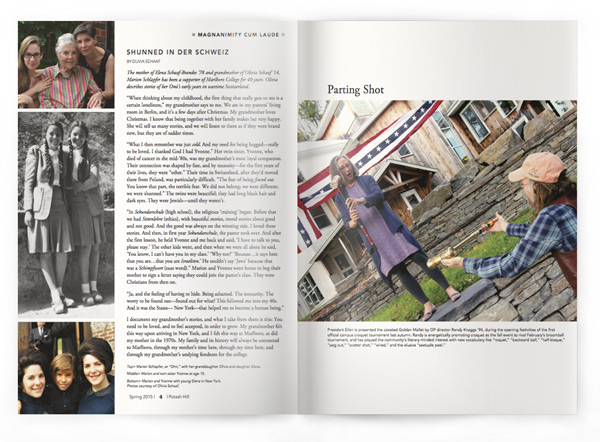
Shunned in Der Schweiz
By Olivia Schaaf
The mother of Elena Schaaf-Brandes ’78 and grandmother of Olivia Schaaf ’14, Marion Schlapfer has been a supporter of Marlboro College for 40 years. Olivia describes stories of her Omi’s early years in wartime Switzerland.
“When thinking about my childhood, the first thing that really gets to me is a certain loneliness,” my grandmother says to me. We are in my parents’ living room in Berlin, and it’s a few days after Christmas. My grandmother loves Christmas. I know that being together with her family makes her very happy. She will tell us many stories, and we will listen to them as if they were brand new, but they are of sadder times.
What I then remember was just cold. And my need for being hugged—really to be loved. I thanked God I had Yvonne.” Her twin sister, Yvonne, who died of cancer in the mid-’80s, was my grandmother’s most loyal companion. Their connection was shaped by fate, and by necessity—for the first years of their lives, they were “other.” Their time in Switzerland, after they’d moved there from Poland, was particularly difficult. “The fear of being found out. You know that part, the terrible fear. We did not belong; we were different; we were shunned.” The twins were beautiful; they had long black hair and dark eyes. They were Jewish—until they weren’t.
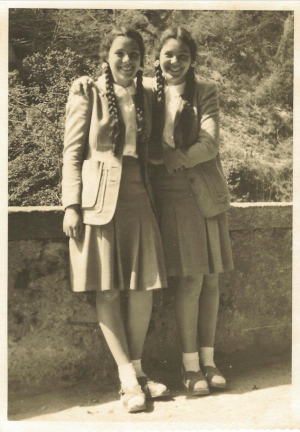 “In Sekundarschule (high school), the religious ‘training’ began. Before that we had Sittenlehre (ethics), with beautiful stories, moral stories about good and not good. And the good was always on the winning side. I loved these stories. And then, in first year Sekundarschule, the pastor took over. And after the first lesson, he held Yvonne and me back and said, ‘I have to talk to you, please stay.’ The other kids went, and then when we were all alone he said, ‘You know, I can’t have you in my class.’ ‘Why not?’ ‘Because…it says here that you are…that you are Israeliten.’ He couldn’t say ‘Jews’ because that was a Schimpfwort (cuss word).” Marion and Yvonne went home to beg their mother to sign a letter saying they could join the pastor’s class. They were Christians from then on.
“In Sekundarschule (high school), the religious ‘training’ began. Before that we had Sittenlehre (ethics), with beautiful stories, moral stories about good and not good. And the good was always on the winning side. I loved these stories. And then, in first year Sekundarschule, the pastor took over. And after the first lesson, he held Yvonne and me back and said, ‘I have to talk to you, please stay.’ The other kids went, and then when we were all alone he said, ‘You know, I can’t have you in my class.’ ‘Why not?’ ‘Because…it says here that you are…that you are Israeliten.’ He couldn’t say ‘Jews’ because that was a Schimpfwort (cuss word).” Marion and Yvonne went home to beg their mother to sign a letter saying they could join the pastor’s class. They were Christians from then on.
“Ja, and the feeling of having to hide. Being ashamed. The insecurity. The worry to be found out—found out for what? This followed me into my 40s. And it was the States— New York—that helped me to become a human being.”
I document my grandmother’s stories, and what I take from them is this: You need to be loved, and to feel accepted, in order to grow. My grandmother felt this way upon arriving in New York, and I felt this way at Marlboro, as did my mother in the 1970s. My family and its history will always be connected to Marlboro, through my mother’s time here, through my time here, and through my grandmother’s undying fondness for the college.
Parting Shot
President Ellen is presented the coveted Golden Mallet by OP director Randy Knaggs ’94, during the opening festivities of the first official campus croquet tournament last autumn. Randy is energetically promoting croquet as the fall event to rival February’s broomball tournament, and has piqued the community’s literary-minded interest with new vocabulary like “roquet,” “backward ball,” “half-bisque,” “peg out,” “scatter shot,” “wired,” and the elusive “sextuple peel.”
Special Web Features
Beloved on the earth: An interview with Lynette Rummel, politics professor
Lynette Rummel was visited by sophomore Shannon Haaland to talk about international development in Africa, the Arab Spring, and “that community thing” at Marlboro College.
Shannon Haaland: So, how long have you taught at Marlboro?
Lynette Rummel: Oh dear, don’t ask that question, because it’s been forever. Once you get to heaven you don’t want to leave—that’s the point. I moved around a lot before, but yeah, since I’ve come here I’ve been a pig in shit. You’re going to clean this up, right?
SH: I don’t know.
LR: I can’t be saying all these ‘bad’ words.
SH: Anyway, where did you teach before?
LR: Well let’s see. I taught at UCLA while I was finishing my Ph.D. there. And as a teaching assistant I was chosen to be the teacher of TAs. I started at Virginia Tech and taught for three years before I went to Tunisia, and taught at the university there for three years. Then I came here. So that adds up to lots and lots of years.
SH: I’m not doing the math. How has your work in development affected your teaching?
LR: Well you should be able to answer that—you’re in all my classes.
SH: Pretend I know nothing.
LR: So when I started in the field of African studies I had assumed I was going to go into development as a career path. But as I learned and gained insight I realized that a lot of the problem was really how Americans think about Africa and about the “Third World.” I felt my bigger task, the more appropriate task for me, was to teach Americans how to understand Africa and let African development be a more indigenous undertaking.
I do feel that my commitment to research in the field, and time on the ground, has compelled me to go back as often as I can. And I find, and I think that you could verify the fact, that all of my experiences in the field help me to be a better teacher in the classroom. I try to use those experiences, and those stories, as a way of bringing the abstract, theoretical complexity—that sometimes becomes a little bit of a mind blow—into focus. To make it real, make it simple, make it understandable. To bring it to life and have that human dimension.
SH: Is there a recent class that has inspired you?
LR: Well I loved teaching Arab Springs, because I have spent so much time in North Africa. Ironically, when I interviewed for Marlboro so many years ago, my talk was about the rise of Islamic fundamentalism that was starting to take root in Tunisia. I was attempting to help Americans understand this new movement, and that it wasn’t about religion as much it was about independence, and identity, and authenticity, and indigenousness. North Africans needed to find their own culture and identity, and this is where their embracing of Islam comes from. But what are you going to do when you are under an authoritarian regime? To overcome that is overwhelming, and it is scary and preposterous to dream about.
And then it happened. In the aftermath, I gave it a year or two to find some clarity on the ground. I was able to teach the Arab Springs class on the five North African countries: Tunisia where it started; and then Egypt where it went next; then to Libya; and then to Algeria—why did it or did it not go there, or had it already; and then what about Morocco. Those are the five countries that I know the most, so it was a thrill to teach about them to that extent. Unfortunately the result of the Arab Springs—the fallout—has not been as promising and as hopeful. We are back in difficult times of power and repression.
SH: When did you teach that class?
LR: Not last spring but the spring before, 2013. Now, this spring I’ll teach about the Maghreb, which refers to the three northwestern countries—Tunisia, Algeria, and Morocco—where I’ve spent the most time. I say the word “Maghreb” and most people don’t even know that word. But I love all my classes—I just love to teach.
SH: Have you had a student who has changed your opinion or your mind on something?
LR: I love when my students jar me, and they do all the time. That’s the lovely thing about being a teacher; I am still a student. I am still learning. In the end, when they become juniors or seniors, they go off and do a plan and they become the experts. I’m just hanging around, benefiting from their knowledge and their insights. Even as freshmen and sophomores—the untrained mind that has not been put into boxes—they say the best things. Usually they are very revealing and very insightful. Sometimes that insight is so honest—we usually have too much of “the academy.”
SH: Favorite quote?
LR: Well, right now I have a poem I could read to you. The background to this story is that my father was dying this past summer, and I was sitting by his side and wanting to talk to him, and wanting to know what was going on in his brain. And after many days of silence—he had brain cancer, so he was having a hard time communicating—one day when I was saying, “Dad, talk to me,” he looked up and said, “I know I am loved.” Which is the most beautiful thing anyone can say.
On the day of his funeral, I am waiting for the funeral to happen—which is a really bizarre place to be—and I’m reading Anne Lamott’s book called Traveling Mercies. I turn the page and—boom—there is this poem called “Late Fragment,” by Raymond Carter, and it goes like this:
“And did you get what
You wanted from this life, even so?
I did.
And what did you want?
To call myself beloved, to feel myself
Beloved on the earth.”
Isn’t that lovely? And I have to tell you that the flowers I got from my students in my dedicated hour group were so incredibly beautiful—I felt loved. I had had a difficult summer, and I wasn’t quite sure if I wanted to come back. All of a sudden I got this incredibly touching—it was just beautiful—bunch of flowers delivered to my door. I went from “I’m not sure if I’m ready to go back, I’m not ready to face the world” to “I cannot wait to come back, I can’t wait to see you all.” And I felt beloved, as I love my students. I know it’s sappy but it’s true.
It was lovely because I had planned to do these “words to live by” in my Dedicated Hour group, and, given my summer, my first adage was going to be “practice kindness.” But y’all had already done it. The flowers from my students—you couldn’t get a more Marlboro story than that—it epitomizes what I love about this place, why I’ll never teach anywhere else. It’s that community thing.
SH: Do you have a recommendation for people who want to be more informed on the political source?
LR: Try to follow news that is outside the country. It’s a pillar from that structure itself. We have to understand the world in non-American viewpoints. Even The Economist, since it’s out of London. Al Jazeera, that’s a better news source for us to realize we have very narrow documentation.
SH: What is the best part about working with students on Plan?
LR: I learn, I grow, I’m challenged. It’s not easy—it keeps me on my toes. That uncomfortable zone, it’s a good zone, but it’s tough. It’s so much work for the student and a lot of pressure and they have such high hopes. It’s not always pretty, I’m learning. I don’t know half of what my students end up writing about. I’ve had so many interesting Plans; I’ve had a student who went to Albania, one who went to Senegal, another who went to Panama—all over the world. They become my eyes and my ears, another way for me to travel. And I love them all—I wouldn’t want anyone of them to think they are not my favorite.